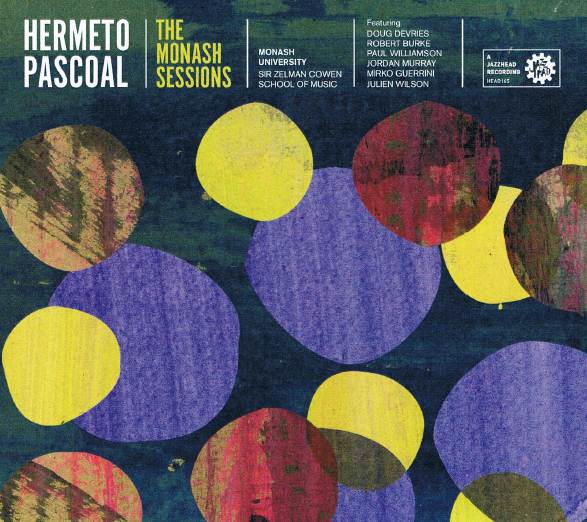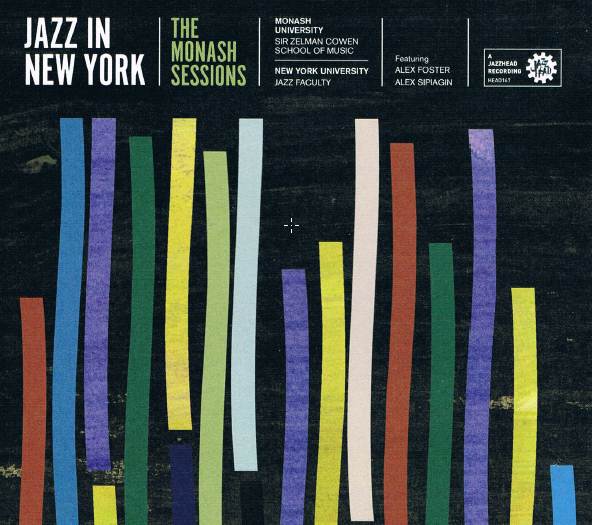Back to recent reviews
Janet Seidel and Friends - Far Away Places
Julien Wilson Quartet - This is Always; Swailing
Monash Art Ensemble (Australian Art Orchestra and Sir Zelman Cowen School of Music)
Simon Thacker's Svara Kanti - Rakshasa
Todd Hardy - Swings and Roundabouts
Captain Kirkwood - Theseus and The Minotaur
Wangaratta Jazz & Blues Festival 2013
Adam Katz - Adam Katz
Resurgence - Duende
States of Play - States of Play
Monash students & overseas artists. The Monash Sessions
Compass Quartet - Oneirology
Keith Jarrett Trio - Somewhere
Hannaford Tinkler and Barker - Faceless Dullard
Steve Newcomb Orchestra - Caterpillar Chronicles
The Vampires - Tiro
The New Cabal
Jonathan Zwartz - The Remembering & Forgetting of the Air
Angela Davis - The Art of The Melody
Yitzhak Yedid - Suite in Four Movements
Paper Plane
Leigh Carriage - Mandarin Skyline
Melbourne International Jazz Festival May 31-June 9 2013
Monique DiMattina - Nola's Ark
Tom Vincent Quartet - Just Enough
Tomasz Stankos New York Quartet - Wistawa
Neil Cowley Trio - The Face of Mount Molehill
Charles Lloyd and Jason Moran - Hagar’s Song
Cecile McLorin Salvant - Woman Child
The catholics - Yonder
Origami - Karaoke
Origami - The Usefulness of Art
Mike Nock and Howie Smith - Opal Dream
BLOW - Empathy
Kjetil Moster - Moster! Edvard Lygre Møster
Edouard Bronson - Intimate
Alex Stuart - Around
Jess Greens Bright Sparks - Tinkly Tinkly
Charmaine Jones and Mike Bevan - Still
Trichotomy - Fact Finding Mission
Phronesis - Walking Dark
Steve Barry - Steve Barry
Alister Spence Trio - Far Flung
Chris Potter - The Siren
Matthew Sheens - Every Eight Seconds
Marialy Pacheco - Spaces Within
Joseph Tawadros - Chameleons of the White Shadow
Ted Vining Trio - Live at PBS FM 1981
Nostalgia 77 - The Sleepwalking Society
Wayne Shorter - Without A Net
Dave Jackson Quartet - Cosmontology
Bobo Stenson Trio - Indicum
Wangaratta Jazz & Blues Festival 2012
Daramad - Daramad
Penelope Sai - Siana
John Surman - The Rainbow Band Sessions
Murphy's Law - Big Creatures and Little Creatures
Slumgum - The Sky his Own
2012 ARCHIVES:
Gregg Arthur - Unforgettable – A Portrait of Nat ‘King’ Cole
Conly, Harding, Jones, Taylor - Grass Roots
Mace Francis New York Nonet - Land Speed Record
Magnet - Magnet
Willow Neilson - Lightbulb Life
Wangaratta Jazz & Blues Festival
Moskus - Salmesykkel
Marc Johnson and Eliane Elias - Swept Away
The Andy Sugg Group - The Berlin Session
Abel Cross Quintet - Neo Bop
Diana Krall - Glad Rag Doll
Divergence Jazz Orchestra- Live at the Bald Faced Stag 29/7/12
Seaman Dan - Sunnyside
Sean Wayland - Slave to the Machine (Volumes 1 & 2)
Logic Live (Double DVD/CD)
Mike Nock and Laurenz Pike - Kindred
James Carter - After All
Tony Gould and Peter Petrucci - The Journey Home
Matthias Schriefl - Six, Alps & Jazz
Simcock, Garland, Sirkis - Lighthouse
Jacam Manricks - Cloud Nine
Sarah McKenzie - Close Your Eyes
Bernie McGann - Wending
Craig Scott Quintet - Timeline
Marialy Pacheco 11th August 2012 – Coffs Harbour
Phil Treloar - Of Other Narratives - tracings in the ground of. Collective Autonomy / Volume 3 - Primal Communication
Mike Stern - All Over the Place
Neneh Cherry and The Thing - The Cherry Thing
John Abercrombie Quartet - Within a Song
Josh Kyle - Possibilities
John McAlls Black Money - Alter Ego
Peter J Martin - Waltz for the Wicked
Lily Dior - Let's Talk About It
Wayne Krantz - Howie 61
Motion - The Drowned World
Renaud Garcia-Fons - Solo – The Marcevol Concert
Tim Stevens - Life's Undertow
Guy Strazz Quartet - Eastern Blues
Melbourne International Jazz Festival 2012
Daimon Brunton Quintet - Wha Sa Live
Tim Willis and The End - Keep Your Chin Up
Tim Clarkson - Evolution of Beauty
Vijay Iyer Trio - Accelerando
Esbjorn Svensson Trio - 301
Phronesis - Walking Dark
Melody Gardot - The Absence
Tony Gorman - Tony Gorman's Monday Club
Barney McAll - Graft
Skii Harvey - Bound by History
Sandy Evans and Friends with Guru Kaaraikkudi Mani and Sruthi Laya - Cosmic Waves
Buck Clayton - The Complete Legendary Jam Sessions: Master Takes
Dick Hyman Trio - You're My Everything
Trombone Shorty - For True
Jens Thomas - Speed of Grace
Ben Hauptmann - Yum Yum Tree RecordsCC
David Murray Octets - The Complete Remastered Recordings on Black Saint
Galaxstare - A Time, Times and Half a Time
David Ades & Friends - A Glorious Uncertainty
Tal Cohen Quartet - Yellow Sticker
Alfredo Rodriguez - Sounds of Space
Alex Pertout and Nilusha Dassenaike - Moments in Time
2011 ARCHIVES:
Benjamin Sanz Quintet - Mutation Majeure
Houston Person - So Nice
Compass - Ode to an Auto Rickshaw
The Vampires - Garfish
Charmaine Jones and Mike Bevan - A Small Hotel
Slide Albatross
Marc Hannaford - Ordinary Madness (Quintet) and Sarcophile (Trio)
Dave Brubeck Quartet - Their Last Time Out
Nicki Parrott - Can't Take My Eyes Off You
Keith Jarrett - Rio
Nick Haywood Quartet - 1234
Kellylee Evans - Nina
Ella Fitzgerald - S'Wonderful: Ella in Japan
Liam Burrows With John Morrison's Swing City - All of Me
Michael Feinstein - The Good Life: The Sinatra Project, Volume Two
Gadjo Guitars - L'Amour En Douce
Bridie King - Blue Ivories
Andy Sheppard, Michel Benita and Sebastian Rochford - Trio Libero
Maggie Britton - Ditto – Songs for Alexander
Christian McBride - Conversations with Christian
Phil Treloar - Of Other Narratives
Jeff Riley - Jazz Suite
Quentin Angus Quintet - Retrieval Structure
Robert Burke, Tony Gould, Tony Floyd and Nick Haywood - Live at Bennett's Lane
Mike Nock Trio Plus - Hear and Know
Peter Knight - Fish Boast of Fishing
Marialy Pacheco - Songs that I Love
Bucky and John Pizzarelli - Generations
Emma Grace Stephenson - Jazz Workshop AustraliaCC
Warren Vache and Bill Charlap - 2gether
Ella Fitzgerald - Live at Mister Kelly's
Cedar Walton - Voices Deep Within
Samurai Spirit - Ganbare Nippon
Warren Wolf - WW
Ella Fitzgerald - Best of the BBC Vaults
Rebecca Kilgore with Harry Allen Quartet - Live at Feinstein's: Celebrating Lady Day and Prez
Nick Hempton - The Business
James Whiting - Burbank
Keith Jarrett - Rio
Compass Quartet - Ode to an Auto Rickshaw
Darius Jones Trio - Big Gurl [Smell My Dream]
Memory of Elements - MoE
Laura Fygi - The Best is Yet to Come
"Buck" Pizzarelli and the West Texas Tumbleweeds - Back in the Saddle Again
Dave Ades & Friends @ Venue 505 (9/11/2011)
Wangaratta Festival of Jazz 2011
Sean Jones - No Need for Words
Peter Knight and Dung Nguyen - Residual
Takadimi - New Common Sense
Ingrid James & The Global Collective - Pangaea
Origami Trio - The Blues of Joy
The Andrew Dickeson Quintet - Weaver of Dreams
The Paul McNamara Trio - IndependentCC
Karrin Allyson - Round Midnight
Nicki Parrott and Ken Peplowski - Like a Lover
Rossano Sportiello Trio - Lucky to be Me
Stan Getz - The Clef and Norgran Studio Albums
Sherrie Maricle and The DIVA Jazz Orchestra - Johnny Mandel: The Man & His Music
Leonie Cohen Trio - Sideshow Pony
Cedric Hanriot - French Stories
Laura Kahle - Circular
Lee McAllistair - Spellbound
Adrian Cunningham - Walkabout
Sandy Evans Sextet - When the Sky Cries Rainbows
Mace Francis Orchestra - Chinese Whispers IV
Katie Noonan Elixir - First Seed Ripening
Matt Keegan Trio - Meets David Ades
Harold Lopez-Nussa Trio - El Pais de las Maravillas
Dan Barnett - Somewhere, Some Place, Some Time
Scott Hamilton and Rossano Sportiello - Midnight at Nola's Penthouse
Bill Charlap - I'm Old Fashioned
Duke Ellington - The Great Concerts: London & New York 1963-64
Melbourne International Jazz Festival 2011
Howard Alden - I Remember Django
Elly Hoyt - Pinnacle
Sarah McKenzie - Don't Tempt Me
Jeremy Pelt - The Talented Mr Pelt
My Goodness McGuiness - Insular Peninsula
Pascal Schumacher Quartet - Bang My Can
Browne, Hannaford, Anning - Shreveport Stomp
Cameron Earl Quartet - Run Run
Daniel Gassin Sextet - Which Way
Fran Swinn Trio - Every Dog
Joachim Kuhn, Majid Bekkas and Ramon Lopez - Chalaba
Portico Quartet - Knee-deep in the North Sea
Matt Baker - Underground
Luke Howard and Janos Bruneel - Open Road
The End - The End
Jason Moran and The Bandwagon - Ten
Briana Cowlishaw - When Fiction Comes to Life
Art Tatum - Solo Masterpieces
Allan Vache - Look To The Sky
Jacam Manricks - Trigonometry
Quinsin Nachoff - Forward Motion (FoMo)
Song Fwaa - Ligeti's Goat
Jane Monheit - Home
Bill Allred Featuring John Allred - The New York Sessions
Duke Ellington - From His Treasure Chest 1965-72
David Klein Quintet - My Marilyn
3ofMillions - Abstruction
BluesFest 2011
Amphibious - Alive & Breathing
Jane Irving - Beams
Tim Stevens Trio - Scare Quotes
James Osborne Jazz Collective - Playtime
Renaud Garcia-Fons - Mediterranees
Mark Isaacs's Resurgence Band - Aurora
Nicki Parrott - Black Coffee
"Buck" Pizzarelli and the West Texas Tumbleweeds - Diggin' Up Bones
Lew Soloff and Steve Richman - Sketches of Spain
2002-2010 ARCHIVES
|
Reviews
 
 
 -
masterpiece, -
masterpiece,
 
 -
excellent, -
excellent,
  - good
- good
 - fair, - fair, - poor - poor
To Search for reviews - Key CTRL+F and artist or album name
| 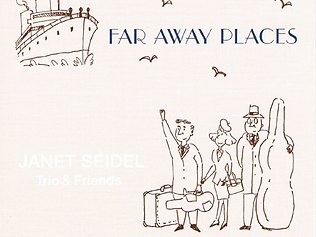 | Janet Seidel and Friends - Far Away Places (Antipodes/Planet)
|
THE 18th album from award-winning Sydney pianist and vocalist Janet Seidel is billed as a fresh sound within an accessible retro style, in a mix of vintage songs from around the world. Certainly these 15 songs are culled from many decades. The earliest, La Paloma, originated in 1863 but has new lyrics here by Seidel.
That time-worn longevity may be one of the problems for the collection; some songs have been recorded 100 times and many have been imbued with deeper and more original vocal expression. There are several fine musicians here including Hamish Stuart on drums, percussionist Fabian Hevia, Paul Furniss on clarinet and Chuck Morgan playing a variety of guitars and ukulele.
Seidel sings each note perfectly with correct phrasing, but strong expression is missing. In a tonal quality reminiscent of Doris Day, she sings the title song -- a hit from 1948 recorded by Margaret Whiting, Dinah Shore, Jo Stafford and others -- to an exotic-sounding backdrop established by Morgan's guitar and ukulele, but she doesn't explore the song's emotional possibilities.
The most jazz-flavoured track, the Ellington theme Take the A Train, features vocalese choruses and a surprisingly good ukulele solo. The album closes with the Beatles' 1969 piece Golden Slumbers presented as an unornamented lullaby. These songs will be a nostalgia trip for many, but they would have been more effective if greater attention had been given to supplying distinctive vocal expression.
  
|
John McBeath
Previously published in The Australian Nov 2013 |
| Back to Index |
| 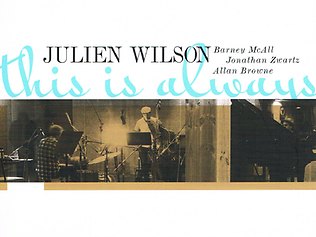 | Julien Wilson Quartet - This is Always; Swailing (Lionsharecords)
|
MELBOURNE saxophonist Julien Wilson was one of the highlights of this month's Wangaratta Jazz Festival where, among other appearances, he launched his quartet album, This is Always.
Considering that only six weeks earlier Wilson had come close to death with anaphylactic shock during a hernia operation and has weakened abdominal muscles, his performances were remarkable.
The new recording brings together a stellar group: New York-based pianist Barney McAll, Sydney bassist Jonathan Zwartz and Melbourne drummer Allan Browne. The title track opener, after McAll's dreamy piano intro, descends deliciously into deeply moving tenor territory as Wilson delivers the theme in a beautiful re-creation of Coleman Hawkins. Then, as a perfect bass line and Browne's subtly sophisticated brushes arrive, Wilson begins to softly explore with superb rhythmic sense, and the effect is everything a nostalgic, romantic ballad should be.
Hawkins's signature piece Body and Soul is reprised, or rather reinvented here at a slower tempo, and roundly imbued with a ceaseless flow of inspired ideas. Six of the nine tracks are wonderfully interpreted standards and the others are Wilson compositions, including a New Orleans style dirge, Farewell, featuring the leader's excellent clarinet against bowed bass
There's an infectiously swinging version of The Party's Over and a slower, luscious rendition of Stairway to the Stars. On the Swailing collection Wilson's well-established trio uses its rather unusual instrumentation, adding Stephen Magnusson's expert guitar and the perfectly appropriate accordion of Steve Grant to Wilson's reeds. Grant's instrument offers melodic and harmonic contributions, and one of the pleasant aspects of this album is the way these components are seamlessly exchanged between guitar and accordion.
There's a sprinkling of standards, including an all-too-short taste of Stardust for just over a minute of superlative tenor, and a quickened, impressive soprano sax workout on Jitterbug Waltz. An almost symphonic opening to Ornette Coleman's Chanting has guitar and accordion continuing a wash behind the tenor's climb into high-register excitement.
Wilson's command of the bass clarinet is evident in his composition Midway, where he lays down an ostinato for the guitar's melodic statement and later overdubs some inspired soprano sax. The sumptuous harmonies of Gabriel Faure's Meditation are unhurriedly explored by meaningful meanderings of the tenor as accordion supplies a backdrop and the guitar adds important countering notes.
Bass clarinet reappears for Magnusson's composition Various and employs some tricky reed effects over accordion chord stabs as the guitar lopes sedately along. Another of Magnusson's originals, My First 2001, after an out-of-tempo beginning, features exuberant guitar jumps as accordion and tenor underscore. A similar sentiment ignites Wilson's Everybody Happy as the tenor hits a jubilant lift-off.
These two great new albums from top-level Australian jazz players can't fail to enjoy widespread appeal.
    
|
John McBeath
Previously published in The Australian Nov 2013 |
Some older listeners may recall an album by Archie Shepp (Live at the Donaueschingen Music Festival 1967) which features one track and one track only- ‘One for the Trane’. It begins with a lengthy bass solo by Jimmy Garrison culminating in his trade mark flamenco style. Memorable. Some of you may also recall David Murray's ‘Special Quartet’ which of course, featured Trane's rhythm section.
My point? Julien Wilson's album ‘This is Always’ has something to recommend it and is not a million miles from comparison with the aforesaid artists, and yet, it is an album of ballads including few ‘war horses’ such as Body and Soul.
In short, we have before us an album "in the tradition" played by seriously accomplished modern musicians at the top of their game. Not a lick in evidence. Quite moving in fact. One of the highlights ‘Wine and Water’ is an original by Mr Wilson and sits appropriately in the middle of this recital. Solos by piano and bass are the highlights. - The track begins with a bass solo (2.04s) which in its power, feeling, timing and construction is a great musical moment.
It sets the bar very high but Mr McAll, whose solo piano recital in St Patrick's Cathedral at the 2013 Wangaratta Jazz Festival was, for me, the highlight of that festival, follows with a solo which moves from the bell like sounds of water falling to a percussive and powerful climax which matches Mr Zwartz's bass. Mr Browne and Mr Wilson support and frame these solos, with some telling cymbal splashes and great timing and touch by Mr Browne on drums.
‘Farewell’ is drenched with feeling and recalls the tradition of ‘Flee as a Bird’ (Psalm 11) and is a stunning coda to a magnificent recital by this "classic" quartet. Mr Wilson is featured on clarinet.
Music is feeling above all, and this album proves the rule. Maximum stars for this album.
    
|
Ian Muldoon
|
| Back to Index |
| 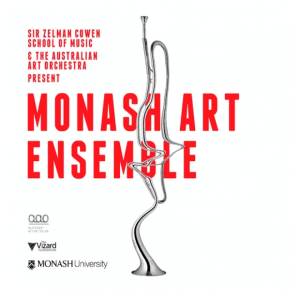 | Monash Art Ensemble (Australian Art Orchestra and Sir Zelman Cowen School of Music) (HEAD 171)
|
THIS comprehensive album consists of two complete works composed and conducted by Paul Grabowsky: a 10-part suite of Variations, based on a theme by Marin Marais (16561728) and Tall Tales, a piece in three movements.A melody by gamba virtuoso Marais, D'un Gout Etranger (In a Strange Style), often described as a culmination in French baroque chamber music, has been brilliantly reworked in contemporary form by Grabowsky. Over an introductory wash of Mitch Mollison's electronics, Eugene Ball's trumpet, then James Macaulay's trombone announce the theme.
Eight extraordinary variations follow, incorporating elements of free jazz, contemporary improvisation, innovative voicings and musical genius. Each of these is inspired by a musical great, from Ennio Morricone to John Coltrane and JS Bach. Amazingly most of the solos are pre-written and all of the variations have an advanced, impressionistic 21st-century, sometimes dissonant, exploratory sound. The second work, Tall Tales, is in three types of musical languages, the first, Ngukurr, Mon Amour, being inspired by manikay song forms of the Yolngu people. This piece alternates bursts of energy with quieter periods, featuring the dazzling work of Erkki Veltheim on five-string electric violin and the outstanding piano of Joe O'Connor. The second part evokes the complex harmonics of Arnold Schoenberg with a marvellous alto solo from Lachlan Davidson, completely notated, and one totally improvised by Scott Tinkler's ceaselessly inventive trumpet. The final track, Wacky, Zany, Madcap is a 10-minute wild ride with various solos, notably by Tony Hicks on tenor.
    
|
John McBeath
Previously published in The Australian Nov 2013 |
| Back to Index |
| 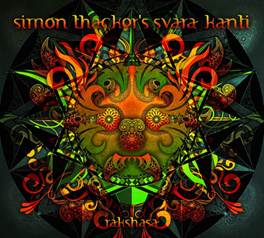 | Simon Thacker's Svara Kanti - Rakshasa (Slap the Moon Records STMRCD02)
|
Scottish based classical guitarist and composer may not be well known to Australian audiences. He is probably best known for his jazz/world crossover projects namely Camerata Ritmata and The Nava Rasa Ensembles exploring the potential between south asian and western music. His newest project Svara Kanti has produced Rakshasa, an album I’d prefer to call new music rather than a feeble and pointless attempt at pigeon holing into jazz or world music. Yes, in truth his keen interest in Indian classical music abounds throughout these pieces however there are strong western classical strands and even Scottish folk melodic reminiscences filtering through the mix. The remainder of the quartet is made up of North Indian Hindustani singer Japjit Kaur, British chamber violinst Jacqueline Shave and tabla extraordinaire Sarvar Sabri. The quartet often finds itself in modes of burning vibrant unison attacks giving way to sunny, sublime new found-lands
Thacker’s musicianship is such that inventive improvisation is not so much an intention but a natural consequence and the music may move through notation into spirited freedom. The instrumentation is an exotic mix of classical guitar, voice, violin and tabla with the highlight and title track employing multi-tracked forwards and backwards recorded guitar, tabla, waterphone and Tibetan singing bowls. Think Jimi Hendrix and The Beatles and what technological possibilities are now available to the artist. The reversal of sound and indeed time opens up some bold albeit heavily produced possibilities of sound manipulation, challenging expectations. In addition to his own compositions, Thacker invited Edinburgh based composer Nigel Osborne to contribute material along with Shirish Korde and US composer Terry Riley with a lengthy 14 minute piece entitled SwarAmant, the longest on the album. SwarAmant opens in chamber mode with guitar and violins before morphing into several periods of dark then rapid fire string dialogue creating tension and several climaxes driven by the intensive tabla of Sabri. If you enjoyed McLaughlin’s Shakti then you’ll enjoy exploring this new strand in Western conversations with India
   
|
Peter Wockner
|
| Back to Index |
|  | Todd Hardy - Swings and Roundabouts (Independent)
|
Unlike his most recent influence Lee Morgan, busy Sydney trumpeter Todd Hardy has chosen mostly standards for his third album as leader. The disc opens with two of his own originals followed by an authentic resemblance of the New Orleans flavoured Wynton Marsalis composition ‘In the Court of King Oliver’. He throws in a relaxed vocal on My Blue Heaven and a velvet toned flugelhorn on ‘Everything Happens to Me’. The album is quite tasteful and leisurely, but if you enjoy Dan Barnett’s albums then you’ll like this one too. The most spritely tune is the funky bossa nova arrangement of Old Devil Moon set up by Andrew Dickeson’s drums. Hardy has a warm, pleasant tone on trumpet and flugelhorn unknotting some inventive and melodic solos in these tunes. His other formative influence Louis Armstrong is a natural reference especially on ‘The Way you Look Tonight’. Brad Child on tenor saxophone is a good foil for Hardy, sometimes feathery and fleeting at other times deliciously grubby, while the ever present and instinctive accompanist, John Harkins on piano never fails to please in this straight ahead setting
  
|
Peter Wockner
|
| Back to Index |
|  | Captain Kirkwood - Theseus and The Minotaur (Independent)
|
Sydney trumpeter and composer Ellen Kirkwood has chosen an individual path to combine contemporary jazz interweaving and illustrating spoken words; not the more familiar abstract poetry, but an iconic Greek story. The 37 minute narration by Ketan Joshi over five tracks is accompanied by Kirkwood’s quintet playing her compositions of composed and improvised music. Receiving the Jann Rutherford Memorial Award in 2012 enabled Kirkwood to form the band and write this comprehensive suite. The legendary story of the hero Theseus slaying the human-eating monster Minotaur, and retracing his steps out of the maze via unwinding a ball of string supplied by Ariadne, the king’s daughter, is of epic proportions. The music interprets each narrative step with Kirkwood’s clear, soft trumpet tonality and Paul Cutlan’s reeds to the fore. Especially notable is Cutlan’s bass clarinet snorting and roaring along with Alon Ilsar’s tension-heightening drumming when the minotaur appears. Quick trumpet phrases also add to the climax, before a quieter passage from Glen Doig’s piano and Tom Botting on bass lead to the conclusion. Three more ‘Other Tunes’ by the leader are in the collection, of whichDharamsala is a beautifully descriptive ballad featuring a trumpet lead with just a touch of harmony from the tenor sax. Vexation, in a catchy rhythm has more of Cutlan’s tenor work including a solo of great depth of feeling and emotive flexibility from quick scrambles to anguished long notes. This album establishes Kirkwood as an important composer and player of considerable ability. Purists might have preferred the musical content without the narration, but that would detract from the overall dramatic thrust of this impressive production
   
|
John McBeath
|
| Back to Index |
|
Wangaratta Jazz & Blues Festival
Various venues
Nov 1 - 3 2013
The camaraderie of jazz musicians was on display at the twenty fourth Wangaratta Festival where numerous touching tributes were paid by artists honouring the late saxophonist Bernie McGann. A poem dedicated to McGann, one of the festival’s top line regulars, was read by poet Geoff Page at aFriday night function organised by Extempore Publishing.
This year the overseas headliners were often overshadowed by a superb collection of great Australian players, selected by Artistic Director Adrian Jackson. Most of the best imports – guitarist Peter O’Mara, vocalist Chris McNulty and pianist Barney McAll – were actually born in Australia.
US pianist Gerald Clayton with his trio was the opener, playing a program of originals from their album Life Forums, streamed live online by the ABC. Although Clayton played with advanced technique, the content seldom reached an adventurous or original improvisational level. The easily accessible material though was certainly a crowd-pleaser. In a later appearance Clayton generously performed with several groups of Monash Jazz Studies students.
Another crowd-pleasing headliner was the Netherlands quartet Gatecrash led by trumpeter Eric Vloeiman featuring heavy use of electronics on keys and trumpet and rock-inspired drums ‘n’ bass. Vloeiman looked the total showman in shiny pink trousers, Hawaiian shirt and flashy silver shoes, but it’s doubtful if persistent reverb effects added value to his competent, easy-listening trumpet style.
Unusually for a jazz combo the Mace Francis Nonet has leader and composer, Francis out front directing nine fine young Perth musicians, all capable of both impressive section playing and soloing. His compositions were interesting and intelligent with something to say, while the voicings utilising tenor and alto sax, bass clarinet with trombone and trumpet were remarkable.
Trumpeter Peter Knight’s well-established Melbourne group Way Out West has achieved a combination of Asian and African influences with contemporary jazz. Employing a wide range of percussion by maestro Ray Pereira, including the marimba-related balafon, and the multi-stringed, flatbed Japanese koto beautifully integrated by Satsuki Odamura, the group adds the imaginative guitar of Lucas Michailidis to saxophone and trumpet plus double bass and drums. A section featuring koto and double bass brought a rare, exhilarating blend of Asian and European strings.
Melbourne saxophonist Julien Wilson appeared in several different groups, notably leading a quartet including New York pianist Barney McAll playing pieces from their new album This Is Always. When Wilson’s tenor sax opened with the title track ballad, the depth of feeling and consummate playing was like a stunning recreation of US tenor great Coleman Hawkins. With Jonathan Zwartz’s perfect bass lines and veteran drummer Allan Browne subtly underpinning, adding McAll’s filigree piano, this was a memorable festival moment.
Another high spot involving Wilson came when together with guitarist Stephen Magnusson and celebrated pianist Mike Nock the trio embarked on their own compositions. A highlight was in Wilson’s Rebellious Bird when the three virtuosos, interweaving an abstract narrative, lifted a momentous performance into climactic magic.
Young Sydney quartet The Vampires were joined by New York trombonist Shannon Barnett further colouring the front line of sax and trumpet, to present numbers from their various recordings, including their latest, Tiro. An electric quintet was headed by Austrian-based guitarist Peter O’Mara, featuring vibes and keyboards plus drums and bass in attractive mixes with adequate space for all to solo in a smart collection of electronica colorata.
Belgian pianist Jef Neve in his third appearance at Wangaratta played solo piano, beginning by strumming the bass strings for a thrumming effect that segued neatly into a florid rendition of the ballad Lush Life ornamented with dramatic musical flourishes. Neve didn’t hit a groove until his third piece, Monk’s Avenue, breaking into stride piano for a couple of choruses.
Vocalist Josh Kyle sensitively accompanied by pianist Sam Keevers, a Melbourne duo, performed a program of all-Australian jazz compositions for which Kyle has written lyrics. The 27 year-old singer has a high alto range capable of sustained notes, exacting control, and expressive depth.
One of just three vocalists this year was New York based Chris McNulty, ably backed by guitarist Paul Bollenback and Ugonna Okegwo on acoustic bass. It was a trio with high professional gloss and McNulty delivered various standards in her expressively individual style using touches of scat interspersed with fine solos from the other two.
Prizemoney of $10,000 and a recording contract for first place in The National Jazz Award (piano) went to Joseph O’Connor from Melbourne.
Organisers confirm that attendances were over 25,000, up from 20,000 in 2012.
A wildly ecstatic late night session was the Sunday night closer, led by pianist Paul Grabowsky with a stellar line-up of soloists: Jamie Oehlers, Andrew Robson and James Greening as inspired raucous abandon stomped the stage. Bernie McGann would have loved it.
|
John McBeath
|
| Back to Index |
| 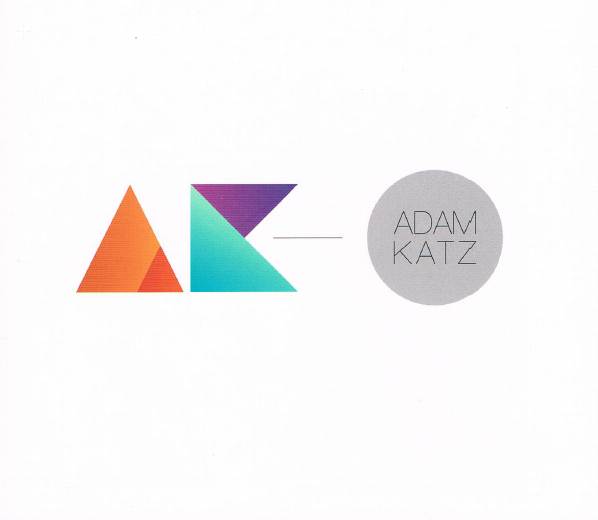 | Adam Katz - Adam Katz (Newmarket)
|
Following the release of this new, self-titled album, Melbourne pianist Adam Katz was recently nominated amongst five finalists in the Melbourne Prize for Music Development Award with a prize of $13,000. This collection utilises six other Melbourne musicians plus US drummer Keith Carlock who recorded his parts in New York playing with guide tracks which the rest of the group then over-recorded in a seamless Melbourne production. The five tracks are all Katz’s compositions and he plays piano on each of them. Julien Wilson – fast becoming the tenor saxophonist of choice in Melbourne – appears on Mistral, adding emotive force to a piece of melodic interest with elements of soft rock rhythms, along with bassist Brendan Tsui, where after the building of intensity by piano and sax, Carlock executes a stylish, rapid drum solo. Ben Anderson takes over the sax role with soprano on Working Title and Nic Lam adds a rock-oriented guitar minus howls and shrieks as the piano moves from strong chordal backing to a quieter, flowing solo gradually increasing in strength for the soprano’s re-entry. A quietened piano and bass are the sole instruments in Interlude a pleasant wandering excursion in a relaxed mode, while Christian Meyer is the guitarist on Blue Pants, another soft rock exercise with mobile piano, flaring guitar and drums that tick along with the pulse. Lullabye, consists of a semi-classical solo piano moving in a pleasing harmonic structure at a slow, steady pace with satisfying resolutions and a stately, unhurried atmosphere. This is an album of top class playing and shows that Katz is a fine pianist capable of engaging, often dulcet compositions
   
|
John McBeath
Previously published in The Australian |
| Back to Index |
|  | Resurgence - Duende (Grace Music/Planet)
|
This latest album from well-established Sydney group Resurgence, led by esteemed pianist Mark Isaacs maintains the same quintet personnel as their 2011 recording, Aurora, with one addition: vocalist Briana Cowlishaw. Also continued is the growing repertoire of Isaacs’s melodic compositions, including lyrics for one song. The front line of saxophonist Matt Keegan and James Muller on guitar is as good as ever, and Tim Firth on drums with bassist Brett Hirst ensure ritmo perfecto. The mood is often subdued, melancholy at times, and invariably soothing, perking up occasionally, such as on a sprightly Gnosis utilising strong, driving solos from sax, guitar and piano. The ethereal vocal sounds of Cowlishaw add a further dimension to three of the nine tracks, notably on You Never Forget Love, a romantic ballad reprised as the final number. On First Light the wordless vocals are scripted as an additional instrument, rising, hovering and soaring mystically amongst the others. The title track, Duende, also reprised, gives the piano introspective freedom to ruminate in a sombre piece with anguished yet satisfying, almost classical harmonies. The same applies to the following track, The Beloved as it drifts dreamily through Muller’s flowing guitar embellishments and the piano’s embroidery. New Lives – the longest track at just under ten minutes – is more joyful with a sparkling piano and guitar bounding into the opening before the sax arrives with the theme and then a solo accompanied by just drums, punctuating smartly, before a hustling percussion solo. Throughout the collection Isaacs’s expert piano supplies pleasing quantities of variation and motile interest, spreading big chords and elaborating melodically, often delightfully, on his own – always engrossing – compositions
   
|
John McBeath
Previously published in The Australian |
| Back to Index |
|  | States of Play - States of Play (Newmarket)
|
This debut album by Melbourne ensemble States of Play led by marimba/vibraphonist Elissa Goodrich has evolved from an acclaimed world-jazz collaboration of Goodrich and composer Clare Shannon. Most of this current album is jazz-influenced music inspired by Spanish forms, but two tracks foreshadow the group’s forthcoming CD featuring adaptations from Bach’s Cello Suite No 3. Those two pieces, Into The Continuum I and II make use of Phil Bywater’s alto sax, as the vibes – perhaps a shade under-recorded – interweave; the second part opening with Tamara Murphy’s acoustic bass is joined by Daniel Farrugia’s mallets on cymbals, before the saxophone plays the theme over cool and soothing vibes. Whilst the Bach derivation is not immediately obvious here, nevertheless both works have a melodically pleasant, very relaxing sound and can stand on their own merit. Of the other nine, Spanish style tracks, Compas begins with a typical hand-clapping flamenco beat and soon develops into vibes, bass and drums with Bywater adding Andalusian flute interplay, then featuring strong jazz-based solos firstly on bass, then flute and vibes, building to an ensemble crescendo. Ninos en La Plaza has an evident Spanish-tinged melody and structure providing a basis for the most forceful jazz-impacted solos from bass and sax. The following track, Conversation in 3 part I is at the opposite end of the rhythmic spectrum floating languidly with vibes and restrained bass to introduce a slow ballad approach for the alto. This is an unusual album blending jazz ideas and improvisations into various Spanish modes and rhythms, utilising the soft, mellow tones of the vibraphone together with sax or flute as the front line
   
|
John McBeath
Previously published in The Australian |
| Back to Index |
|
Monash students and overseas artists. The Monash Sessions (JazzHead)
Three albums herald the launch of the most comprehensive, global program of any tertiary jazz studies course in Australia. Monash University’s Sir Zelman Cowen School of Music in Melbourne not only offers students the opportunity to study, play and record with visiting overseas headline performers, it also takes around forty students annually to international destinations for this purpose. The outstanding results can be heard on the first three albums of The Monash Sessions consisting of performances with (i) Brazilian multi-instrumentalist Hermeto Pascoal; (ii) Monash Uni Big Band plus three smaller ensembles with American tenor giant George Garzone; (iii) Various small groups of faculty and students from Monash and New York Universities, plus other New York players. Further recordings, including sessions in Italy with trumpet maestro Enrico Rava and Australian performances with esteemed vocalist Vince Jones, are scheduled for next year
First in the Monash Sessions series is an album of six tracks all composed by Hermeto Pascoal with various groups including Pascoal, students and faculty members, plus Australian specialist in Brazilian guitar, Doug De Vries. Pascoal, known in Brazil as O Bruxo (the sorcerer) is renowned for using unconventional objects and on the opener Bebe, he can be heard singing a surprisingly effective, bubbly scat chorus into a glass of water. In another piece Pascoal joins the Latin rhythm ensemble with a speeding melodica after a powerful trombone solo from Jordan Murray and Dan Mamrot’s authentic-sounding traditional guitar
The George Garzone collection has the tenor out front of the 19-piece Monash Uni Big Band presenting several standards and one original arranged by Garzone’s long-term associate Greg Hopkins. Horace Silver’s Nutville has Travis Woods’s vigorous driving trumpet over jabbing brass in addition to Garzone’s breathtaking solo. Five more tracks feature Garzone playing his own compositions with two different smaller Monash ensembles. Another three pieces close the session with the Small World Ensemble, including a spectacularly energetic version of I Remember You with just Chloe Dempsey’s drum accompaniment. The album is a breath-taking display of Garzone’s virtuosic technique, his inventive chord shifts, effortless high register excursions, and strong swinging ability, against different backdrops of impressive talent
The third album, of eleven tracks, Jazz In New York, is presented by six different ensembles and there are many remarkable moments and soloists appearing in these fine line-ups. Some groups include members of the New York Uni jazz staff and others utilise local jazz artists, such as legendary patriarch, pianist Sy Johnson who played and arranged for Charles Mingus, and each combo contains high calibre performances from Monash students.
Rob Burke, Head of the School of Music and his supporting faculty are to be congratulated on establishing the Monash Sessions program providing wonderful opportunities for jazz studies students including international prospects, master classes and mentoring
   
|
John McBeath
Previously published in The Australian |
| Back to Index |
|  | Compass Quartet - Oneirology (Earshift Records)
|
Sydney’s Compass Quartet comprises each of the four instruments in the saxophone family, led by award-winning altoist Jeremy Rose and here they’re accompanied by pianist Jackson Harrison, winner of the 2006 Wangaratta Jazz Festival award. Oneirology (the study of dreams) is mostly a four part suite composed by Rose and inspired by British film director Chris Nolan (The Dark Knight Trilogy) and his production Inception; plus two other originals
The absence of a rhythm section frees the horns to move chorale-like in ensemble harmonies either interspersed with figurative piano, or underscored by that instrument. Sometimes three of the saxes play moving chords or melodic passages as the fourth solos. The whole effect is one of a classical-sounding narrative, ideally suited to the subject matter, established by the first movement, Daydreamer where a soothing, relaxing mood of abstraction pervades. Entering The Subconsciousness takes on a more substantial atmosphere as Mathew Ottignon’s tenor weaves quickly and abstractly against varying horn figures, ending with the piano tinkling in the very high treble. The third movement, Dream Within a Dream features Rose’s fleeting alto after an opening of wandering reverie using the high end of Christina Leonard’s soprano topping the harmonies. The final movement, Reality Check? (Déjà Vu) moves into forthright statements making good use of the depth of Luke Gilmour’s baritone in the stark, murkier passages, then there’s a joyful interplay between piano and horns. The two other tracks continue the phantasmagorical mood of the title suite with glimpses of bop ideas
This is a highly original collection of mood-setting pieces demonstrating inspired compositions and musicianship in a classical/jazz approach using unusual instrumentation
   
|
John McBeath
Previously published in The Australian |
| Back to Index |
| 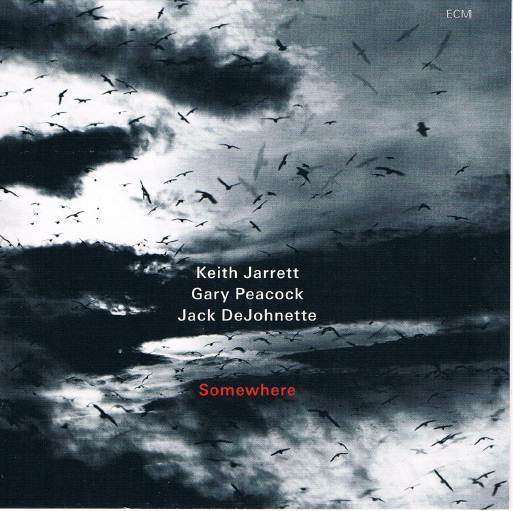 | Keith Jarrett Trio - Somewhere (ECM/Fuse)
|
Legions of followers of US pianist Keith Jarrett will be overjoyed at this first release from his famed standards trio since Yesterdays, recorded in 2001 but only released in 2009. The new album, Somewhere continues with the trio’s long-standing members, bassist Gary Peacock and drummer Jack DeJohnette. Fans might have been wondering if the magnificent trio, after thirty years together, had decided to stop recording. The latest album recorded live in the Lucerne Concert Hall, Switzerland in 2009, banishes all doubts as the trio brilliantly re-interprets six standards
Jarrett is a relatively rare musician on several counts: as a child prodigy he began studying piano aged three and gave his first solo performance at the age of eleven; he’s a prolific composer who’s played with a who’s who of jazz luminaries including Art Blakey, Charles Lloyd, Charlie Haden and Miles Davis. He is also active playing and composing European classical music and spent all of the year 1984 exclusively playing and composing orchestral classical works
The new album comes complete with all of Jarrett’s trademarks: lengthy, inspired intros and codas; effortless mobile invention, and his sometimes irritating little cries. Every track is a standout but the interpretation of Stars Fell on Alabama is noteworthy: after a rubato opening Jarrett manages, with sympathetic assistance from bass and drums, to gradually build a superbly expressive theme and solo into a swinging ballad heralded by Peacock’s discursive bass solo
There are two songs from the music of Leonard Bernstein’s 1957 show West Side Story: firstly Somewhere, roams widely as piano and bass circumnavigate the theme, ever so slowly stoking the tension over twenty minutes into an extended, improvised, grooving coda that Jarrett has entitled Everywhere. The other Bernstein piece Tonight, is taken up-tempo, the fastest in the collection, and features Jarrett’s seemingly endless high speed flow of instant ideas as Peacock and DeJohnette drive it powerfully along, DeJohnette taking a smart solo
An inverted unaccompanied, jabbing sequence from Jarrett introduces Between The Devil and The Deep Blue Sea at a medium tempo, employing clever integrated play between piano and drums as the theme is established. After fast, cascading piano treble runs the bass takes a swinging solo climbing into the instrument’s higher register, followed by a series of exultant eight bar piano and drum exchanges. Closing track is Van Heusen’s lovely ballad I Thought About You where a pensive, late night atmosphere pervades as Jarrett takes many opportunities to extend and embellish the song’s rich harmonies. Again Peacock creates a sublime solo of profound expression by using the resonant bass’s tense upper register followed by the release of a quick downward passage. This album displays the magical empathy between these musicians and re-establishes Jarrett’s standards trio, with its uniquely gifted leader, as one of the top level jazz piano trios
    
|
John McBeath
Previously published in The Australian |
| Back to Index |
| 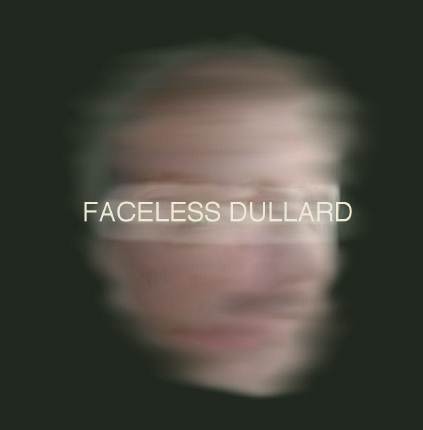 | Hannaford, Tinkler and Barker - Faceless Dullard (Independent)
|
Melbourne avant pianist Marc Hannaford won the 2013 Bell Award for Most Original Jazz Album with Sarcophile. That album featured piano, bass and drums, a traditional piano trio with advanced improvised music that was anything but traditional. This new CD has Hannaford with trumpeter Scott Tinkler, and Simon Barker on drums – an unusual combination by three of the most formidable and accomplished Australian improvisation performers. Virtuosic improvisation is the construct here. It’s 48 minutes of completely unplanned music, an evolved style with no edits or second takes and it demands considerable effort and attention from the listener. Described as “acoustic avant-garde experimental improvisation jazz”, this is different from free jazz and most other improvised music; it’s more a boundary-breaking, individualistic approach with aspects of jazz, contemporary classical music, and most of all instantaneous, interactive composition. Common jazz elements such as rhythmic continuity and cyclic harmonic progressions are absent but this total freedom to pursue ideas as they occur requires a higher level of group understanding. In that regard the trio excels with one or more of the players sometimes falling silent as the others proceed either solo or in supportive dualism. During ensemble passages perhaps the piano will stab and jab at chords or explore spacey themes while the trumpet flies above, often up to very high notes, and the drums add an unlimited variety of percussive effects. About mid-way through the work the piano embarks on a mysterioso sequence inducing VHF long trumpet notes while Barker adds an occasional gong-like cymbal, followed by an imaginatively sustained, hyper-fast drum solo. A triumvirate triumph of abstract expressionism
   
|
John McBeath
Previously published in The Australian |
| Back to Index |
| 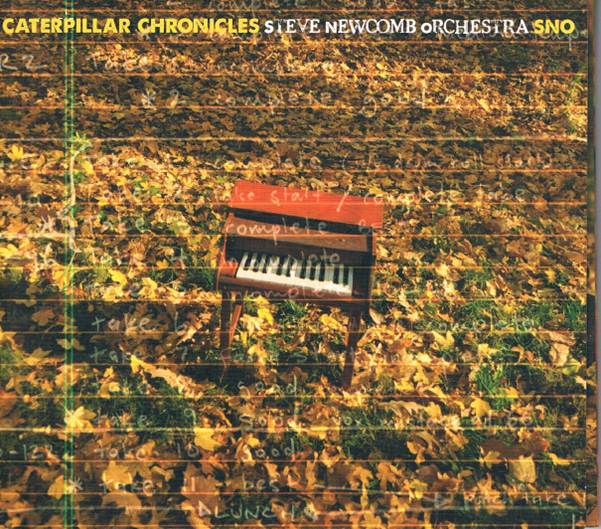 | Steve Newcomb Orchestra - Caterpillar Chronicles (Listen Hear)
|
There is a total of eighteen musicians performing on this album recorded in New York with a contingent of eight New York based Australians and other musicians from that city. The music evolved from pianist Steve Newcomb forming a trio with Australian bassist Sam Anning and French drummer Wilhlem Flouzat while all three were studying at the Manhattan School of Music. Then came the idea of adding a string quartet. Before long bass clarinet, baritone sax, trumpet, flute, French horn, harp, guitar, trombone, tablas and vocals were all enlisted forming an orchestra to play Newcomb’s compositions. And these are formidable works. The opening track Three To Get Ready, and the longest at over ten minutes, begins with Flouzat’s smart, up-tempo drum solo, joined by staccato piano as strings start to emerge in subsiding waves as piano bass and drums swing strongly and the piece builds, alters tempos and moves into a symphonic-style jazz arrangement of many instruments. The title number, Caterpillar Chronicles is made up of six tracks of varying moods from a semi-classical solo piano adding a lyrical flugel horn, moving to a rhythmic interlude with Nord keys, trumpet and tablas; even a multi-instrumental chorale sound with Kavita Sha’s solo voice and a cute little intro by Newcomb’s five year-old daughter. Three pieces, Remnants I, II & III are scattered throughout where themes are reinterpreted both melodically and rhythmically. This album is a co-operative undertaking of huge proportions utilising an entire orchestra to perform Newcomb’s expert arrangements where the widely differing atmospheres and instrumentation are underpinned and thematically linked by the composer’s skilful piano-led trio
   
|
John McBeath
Previously published in The Australian |
| Back to Index |
| 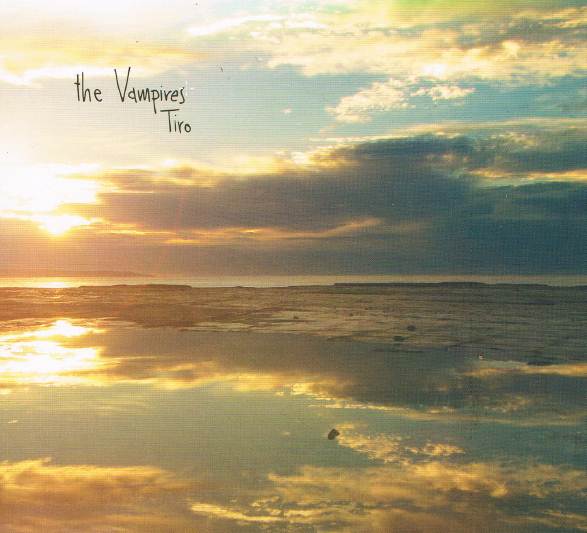 | The Vampires - Tiro (Earshift Records)
|
Young Sydney quartet, The Vampires’ fourth album continues their original material with its emphasis on melody, adding a strong sense of dialogue and emotional range. Altoist Jeremy Rose wrote six of the pieces and trumpeter Nick Garbett contributed the other five. Although the band’s website quotes Rose saying the new album is ‘taking a new direction for the group’, fans of their previous three recordings, most recently Garfish in 2012, are unlikely to agree. The front line duo sound of brass and reeds remains and their melodic integrity is strong, combined with originality and musical narrative. However there are a couple of differences: some new rhythms are explored and in addition to alto, Rose plays tenor and soprano sax as well as clarinet, while Garbett adds flugelhorn to the trumpet, and Alex Boneham uses both acoustic and electric bass. Exploratory rhythms are delivered well in the title track’s catchy theme with Garbett soloing impressively on flugelhorn, and a very short, under a minute, slower remix is also included. Zen Cowboy achieves just the right ‘south of the border’ sound after a mariachi-style beginning and Rose contributes a flying soprano solo over thrusting bass and Alex Masso’s swiftly changing percussion. A deep, bluesy core inhabits Palau as Rose adds the tenor’s body to the theme under trumpet and spreads out in a soulful solo ahead of Boneham’s sympathetic acoustic bass. This album is a worthy addition to the growing collection of engaging Vampire compositions played with individual flair, all of which will be on display during a comprehensive national tour running from October until December
   
|
John McBeath
Previously published in The Australian |
| Back to Index |
|  | The New Cabal (Independent)
|
This Adelaide quartet includes some of the city’s top-flight jazz performers on their debut album. Led by acoustic bassist Lyndon Gray the group continues as a weekly attraction over its four-year residency at the Victorian parlour cocktail venue, La Boheme. The material here ranges from a Mexican traditional piece, and a song by indie-folk artist Elliott Smith, to band originals, all in a cutting edge post-bop style. The leader’s skilled bass work is evident throughout whether soloing, sub-strata underpinning, adding a melodic voice or providing an intro. On Psycho Remake the bass intro with drum accompaniment from Kevin Van Der Zwaag and soft chords from Chris Martin’s keys sets a jumpy psychological mood for the entry of Chris Soole’s tenor sax. Later in that piece the bass flies into a solo against stopped staccato backing to lead into Soole’s speeding tenor spiralling up to neurotic high register intensities. The Mexican number El LLorar (The Cry) has the piano setting an unusual galloping tempo for enlivened solos from bass and tenor, while Smith’s composition Everything Means Nothing to Me features Soole on soprano sax threading the melody firstly through Martin’s flowing piano, then gradually subsiding for Gray’s exploratory bass. Bash Bam Crash Whack Smash energetically portrays its title with some impressively strong tenor work plus distorted keys backed by bam-crash drums, contrasting with Millody, a romantic ballad with sensitive pairing of tenor and deep piano chords. Soole’s tribute to the late US saxophonist Michael Brecker, Blues for Mike, is a slow-burning blues with Soole igniting the twelve bar format, featuring yet another bass-on-fire solo from Gray and Martin’s jabbing, tinkly keys
   
|
John McBeath
Previously published in The Australian June 2013 |
| Back to Index |
|  | Jonathan Zwartz - The Remembering & Forgetting of the Air (Independent)
|
One of numerous advantages to being amongst Australia’s leading musicians is that it’s never difficult to persuade other top players to join in your projects. This is especially true of Sydney bassist Jonathan Zwartz winner of two Bell Awards in 2010 for his stellar sextet album The Sea. Most of those performers are included on his latest album, this time though it's a larger group of nine from the cream of Australian jazz players. The mood is set by a rustic quotation from American Pulitzer Prize-winning poet Mary Oliver, a specialist on the natural world and dream imagery. The tempos on these Zwartz originals are all slow to medium in a mostly mainstream style of often quite dreamy textures. Pianist Barney McAll opens Sugar Hill Picnic with a bluesy feel of almost somnolent relaxation lifted somewhat by James Greening’s gutsy, growling trombone and Phil Slater’s New Orleans trumpet. A similar atmosphere pervades Wait Until The Morning where Richard Maegraith delivers a soulful tenor sax solo of almost heart-breaking intensity but the ensemble horns seem to wander aimlessly. More of a jog-along tempo opens Shimmerand continues as cascading treble piano flows over the prettily voiced front line. No one is challenged here as the slower tempos and long ensemble notes impart a certain kind of fragility but musicians of this calibre are capable of far more adventurous and exploratory work. A bonus CD with two lengthy tracks is included, both at a medium tempo: Henry’s Highlife’s bouncy theme is accompanied by cling-cling pop-style piano chords, but lift-off solos from tenor, trombone and Stephen Magnusson’s guitar inject excitement
   
|
John McBeath
Previously published in The Australian June 2013 |
| Back to Index |
|  | Angela Davis - The Art of The Melody (Nicholas Records)
|
From the burgeoning numbers of Australian jazz players based in New York comes a debut album from 27 year-old alto saxophonist Angela Davis, ex Toowoomba, Qld. Bassist Linda Oh and drummer Rajiv Jayaweera are also from Australia leaving pianist Chris Ziemba as the only American on this New York recording. The title is perfectly fitting since the collection is very melodic in content and improvisational style. Davis, a student of Lee Konitz, has a beautifully elegant, honeyed alto tone, reminiscent of Paul Desmond. Three of the nine tracks are originals and the others are a varied selection, from the Scottish traditional Annie Laurie to the gracefully interpreted ballad Crazy She Calls Me and Tom Waits’s Martha – all are tunes of strong, emotive melodies. The opener, 41. St Nick an original, is a quick post-bop theme stated by piano and alto in unison before the alto solos with just bass and drums travelling smartly in a supportive groove. After a short piano and bass intro plus the theme from alto, the 1976 Boz Scaggs song, We’re All Alone evolves into imaginatively flowing piano from Ziemba, a Juilliard graduate, who injects a swinging feel into his solo, followed by Davis’s lyrical take on the piece with just piano accompaniment. Linda Oh’s always strong bass introduces the original Conscientia, continuing to move and propel under alto and piano solos embellished by Jayaweera’s soft brushes before an inventive, rhythmic bass solo. This is not avant-garde work, but it’s a well-played testament to melody with the ghost of Paul Desmond hovering throughout
   
|
John McBeath
Previously published in The Australian June 2013 |
| Back to Index |
|  | Yitzhak Yedid - Suite in Four Movements (Between The Lines Records)
|
Yitzhak Yedid is an Israeli pianist who studied Arabian and Western music in Jerusalem, studied also in Boston with Paul Bley, and for the past six years has been resident in Australia. This new suite continues Yedid’s merging of classical Arabic music, Arabic-influenced Jewish music, contemporary western classical and aspects of avant-garde jazz-flavoured improvisation. The album was a nominee for Most Original Jazz Album in the 2013 Bell Awards. Accompanying Yedid are long-term associates, Sami Kheshaiboun on Arabic violin and Ora Boasson Horev on double bass. It’s an eclectic performance reflecting the tensions between Eastern and Western cultures with the emphasis on fusing Arabic and Western classical contemporary music. The first movement of six parts opening with Taqsim, dedicated to the day of tomorrow features solo percussive staccato piano using deadened strings. The second part, Image of an Old Weary Man has high register violin, plus bass and piano sympathetically creating a tremulous portrait. The second movement opens with a dissonant clash on the piano introducing a prayerful violin theme, altering immediately for the busy tempo of The Dancers’ Gleeful Cries. The third and most impressive movement is dedicated to a Holocaust survivor: a tense spectrum evoking distress, anguish and empathy. The final movement is the liveliest, opening with Cries of Joy and containing The Madness of Creation, which soars, leaps, and stomps into a tranquil Epilogue. The brilliantly executed suite makes demands on the listener. Intended to be heard in one sitting, each movement presents a soundscape of almost cinematic images ranging from shattering clashes to soothing serenity
   
|
John McBeath
Previously published in The Australian June 2013 |
| Back to Index |
|  | Paper Plane (Independent)
|
The debut album from this Melbourne quartet features three graduates from the Elder Conservatorium, Adelaide: guitarist Hugh Stuckey, bassist Sam Zerna, and drummer Hugh Harvey plus Melbourne saxophonist Kieran Hensey. Their music is a unique kind of cerebral cool, often rhythmic but not hard-driving with drums contributing additional melodic input rather than a heavy beat. The opener Be Brave begins with soft guitar chords, joined by tenor sax in the theme’s tonal stepping-down before an introspective guitar solo then an agile tenor as the drums emphasise and punctuate. There is a dreamy, floating quality to the collection exemplified by the tenor’s long held notes in Remnant or the guitar and tenor unison work in Line of Thought and later the guitar’s embroidered interaction as the tenor glides unobtrusively. Quiet restraint is the keynote in Spinning Gears as bowed bass underpins ethereal guitar and tenor while busily inventive drum action becomes the foreground. Slower tempos are a characteristic throughout the album and Frog’s Remorse follows that pattern as the tenor delivers an aching solo and then flowing guitar lifts the mood. The only non-original of nine tracks, Duke Ellington’s bluesy Jump For Joy, is taken at a slower pace than that usually heard on this standard; more a smooth slide than a jump but it’s none the worse for that. It’s the most rhythmic in the collection with Harvey’s skilful brushes at first then sticks, and both guitar and tenor inject a deep Delta feel into their solos. This album by talented players is rewarding for its unusually contemplative approach
   
|
John McBeath
Previously published in The Australian June 2013 |
| Back to Index |
| 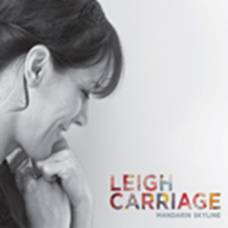 | Leigh Carriage - Mandarin Skyline (Vitamin Records)
|
Australian vocalist/composer Leigh Carriage is based in Lismore, NSW where she is Head of Vocal Studies at Southern Cross University. This first album of her originals was recorded in Sydney with a number of various top-flight Sydney musicians, including bassist Jonathan Zwartz, drummer Hamish Stuart and guitarist Matt Smith as the foundation trio on all tracks. Carriage has a pure, clear voice in a style vaguely reminiscent of Jodi Mitchell. The title song with its lyrics of romantic nostalgia climbs into the upper register with long notes and features a sympathetic trumpet solo from Phil Slater who also ends the track with an appropriate feeling of softness. All ten songs are in a ballad tempo and the overall mood is one of introspection and often melancholy. Spring Uprising abandons sombre tones although the vocal, given the subject matter, might have sounded more joyful; a sprightly piano solo from Sam Keevers lifts the mood. The intro to Breaking Point has an ominous feel as Matt McMahon’s piano builds tension and the high register vocal opening adds to the ethereal atmosphere. Slaters’s mysterioso trumpet intermingles with Carriage’s wordless vocals in Refuge, a haunting theme that ends at a somewhat unexpected point on a high, breathy note. The mournful spirit is a suitable style for the subject matter of Lost Sons and Steve Russell contributes some thoughtfully substantial piano work, particularly in his solo. These are songs of melodic interest, delivered in slower tempos, sung very well and excellently arranged, and they’re probably best heard in a reflective, pensive mood
   
|
John McBeath
Previously published in The Australian June 2013 |
| Back to Index |
|
Melbourne International Jazz Festival
Various venues, May 31-June 9 2013.
MODERN jazz audiences have come to expect a diversity of styles from performers, and in Melbourne last week they got it.
More than 80 international and 400 Australian performers, including 200 students, took to stages across Melbourne for the 16th Melbourne International Jazz Festival.
The entire catalogue of jazz idioms was on display, from trad to avant garde and out-there impressionism.
The 10-day program kicked off with a rock-pop opener featuring three Australian vocalists, Sarah McKenzie, Mahalia Barnes and Michelle Nicolle, where the last named stood out with her superior range, experience and improvisational ability.
First up among the headliners was virtuoso US bassist Christian McBride and his trio. With outstanding accompanists pianist Christian Sands and Ulysses Owens Jr on drums, they delivered reinterpreted standards and originals. Included was an ultra high-speed Cherokee and an even faster version of Oscar Peterson's Hallelujah Time in which Sands's piano sounded astonishingly like the composer's. A lengthy suite based on My Favourite Things demonstrated McBride's mastery, including an ability to produce harmonic chords on acoustic bass.
Mike Stern, a US guitarist with impressive credentials (Miles Davis, Blood, Sweat & Tears, Billy Cobham) fronted his jazz-rock fusion quartet for some very smart, high-speed fingering devoid of guitar howling. His drummer Dave Weckl, also well credentialled, produced some powerfully superb solos.
The 14-piece Monash Art Ensemble directed by Paul Grabowsky explored several advanced compositions, displaying a high level of professional musicianship in complex arrangements.
Byron Bay-based alto saxophonist Dave Ades, winner of two Bell Awards, delivered high-flying passages of searing intensity with expert support from US players Tony Malaby on tenor sax, bassist Mark Helias and Gerald Cleaver on drums.
Their first-time-out ensemble work and cutting-edge solos were articulate and acutely integrated at a memorable late-night club session of Ades originals.
During its 10-year existence Sydney's 18-piece big band the Jazzgroove Mothership Orchestra has gone from strength to strength under the leadership of saxophonist David Theak. Sydney pianist Sean Wayland, now based in New York, appeared with the band, playing arrangements - and conducted - by renowned North American composers Darcy James Argue and Maria Schneider, featuring fine section playing and knockout choruses from its many high-quality soloists. Not the least of these was Theak's high-speed alto improvisation on Argue's Obsidian Flow. Schneider's greater experience was obvious in her sophisticated use of contrasting light and shade in orchestral voicings.
American saxophonist James Carter fronted his trio of a Hammond B3 organ and drums, playing soprano, alto and tenor saxes plus flute. Most of the numbers sounded remarkably similar: fast tempos with squawks, squeals, blurts and clicks all produced in a macho-funk exhibitive onslaught. Carter showed that he also could play sensitively in a slow, tenor rendition of Don Byas's ballad Gloria.
Another headliner was 71-year-old multi-award-winning Cuban pianist Chucho Valdes and his Afro-Cuban Messengers playing acoustic bass, drums, congas and bata, a set of three hourglass-shaped drums. The group did not confine itself to Latin styles and often shrank to a trio of piano, bass and drums, introducing familiar standards such as Take Five and But Not for Me, although sometimes tempos switched into a Latin beat. Valdes often sounded like a classical concert pianist playing at high speed and with great dexterity, occasionally dropping into a Cuban groove, scattering high-velocity runs and chromatics, or pounding huge, dissonant Monk-like chords. Frequently Valdes's hands moved in a blur, just as quickly as those of Yaroldy Abreu Robles flashing over his set of four congas. When the trio sank deliciously into a slow blues, the leader worked over that format in an inexhaustible variety of satisfying reinventions. One detracting aspect to a standing-ovation concert was the poor PA balance - too much level on the drum kit and not enough on bass and piano.
The Sunday night festival closer featured extraordinary US vocalist Cassandra Wilson, dubbed "America's best singer" by Time magazine and a groundbreaking winner of many awards. Wilson's performance is a democratic production, with each band member independently sharing the spotlight. She roamed the stage like a wild spirit, barefooted in a long dress, hair tumbling, encouraging and highlighting the musicians.
Their instrumentation was unusual, too: harmonica, violin (doubling on mandolin), guitar, bass and an extended drum kit.
In her smoky delivery, Wilson sang songs from many albums, giving each her unique, economical interpretation of phrasing and melody, leaving ample spaces by stretching out metre. Pop songs, country, blues and jazz all inform her individual style. Wichita Lineman took on new life, becoming almost a contralto blues, and Last Train to Clarksville was revived as a jazz swing item. Her encore, Time After Time, was a show-stopper of delicate ingenuity, altering both time and space, fully deserving its standing ovation.
John McBeath
|
By John McBeath
Previously published in The Australian June 2013 |
| Back to Index |
|  | Monique DiMattina - Nola's Ark (Jazzhead HEAD 170)
|
Monique DiMattina is one talented lady. With songs such as these, her reputation as a singer/song writer will take on a steep trajectory. They have both a great sense of humour and sometimes loads of sensuality. She is re-known for her community radio segment where she takes requests for inspiration to write a song within an hour and some of these gems indeed have such unlikely seeds. No stranger to recording abroad (her first album was recorded in NYC live at the 55 Bar) but this outing sees her in New Orlean’s famous Piety Studios not to mention 20 weeks pregnant in summer heat. Her vocals are reminiscent of Blossom Dearie as are some of her quaint lyrics but she has a Dylanesque swagger with an Aussie vernacular. There’s much to like here especially if you enjoy your music ‘Nawlins’ style. Young at Heart is the surprise opener, played in a trad jazz style that can be awkward if you’re used to Sinatra’s version. DiMattina is a deft pianist in this funky barrelhouse style and she’s almost certainly playing on an upright piano. Dr John’s sousaphonist Matt Perrine keeps the groove both traditional and earthy, while Leroy Jones’s unmistakeable trumpet (think the Ruby Braff tone in a Preservation Hall setting) is irresistible
   
|
By Peter Wockner
|
| Back to Index |
| 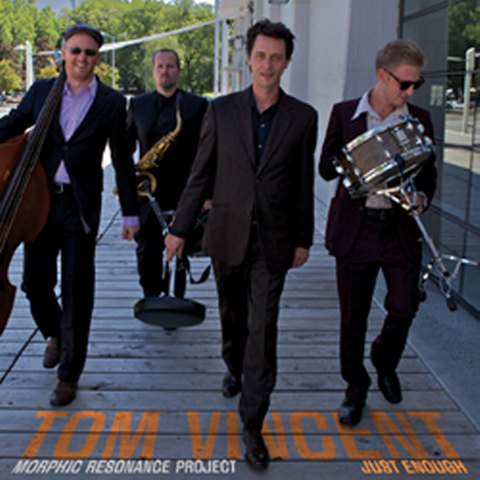 | Tom Vincent Quartet - Just Enough (Lumbini House)
|
Hobart-based pianist Tom Vincent has an extensive CV. Over a 25 year career he’s toured widely with groups in Australia, Asia, Europe, South America, Canada and the US where he resided for three years, studying and performing in New York. On this latest studio album Vincent has written nine of the fourteen tunes. The music is well played and stylistically it’s an evolution from pre-Coltrane bop, with an approach not unlike Coleman Hawkins’ sixties quartet with Red Garland on piano. This is a Tasmanian production, except for Melbourne bassist Leigh Barker. Danny Healy is on tenor sax, Alf Jackson plays drums and the band is on a promotional tour of the Eastern states until May 31st 2013. Three of the pieces are by Thelonious Monk, including a swinging version of Three Chimneys adding a slightly comedic sequence of two bar exchanges between tenor and piano. Another Monk original Rhythm-a-ning features Healey on bass clarinet, marred only by a tendency to inject comic-sounding passages, however the piano comes to the rescue with a driving solo. Vincent’s compositions are varied and interesting especially the ballads, of which Big Creek Wedding is a good example with a melody pretty enough to include in the standards repertoire and How Would You Dream moves gently and soothingly with a faint relationship to On Green Dolphin Street. A medium tempo swinger, Get Together introduces a deftly supportive bass solo, while the title track using piano without the sax opens at a slower pace with effective chords underlining a wandering theme before breaking into double time as it flows descriptively up and down the keyboard
   
|
By John McBeath
Previously published in The Australian |
| Back to Index |
| 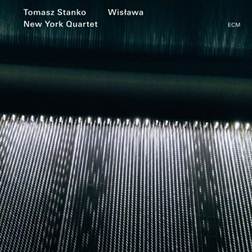 | Tomasz Stanko's New York Quartet - Wistawa (ECM/Fuse)
|
Polish trumpeter Tomasz Stanko, now aged seventy spends his time between Krakow and New York and leads groups in both cities. With his Polish group he was a headliner at the 2005 Wangaratta Jazz Festival and impressed mightily. He now has found an ideal pianist in twenty-nine year old ex-Cuban David Virelles. Stanko’s album is dedicated to the late Polish poet and 1996 Nobel Prize winner Wistawa Szymborska, whose words, he says, gave him many ideas and insights and an impetus to his music. This quartet which includes bassist Thomas Morgan and Gerald Cleaver on drums, might just qualify as Stanko’s most effective and complemental group to date from an already impressive ECM collection. The double album set of originals incorporates a diverse range of moods from the vulnerable anguish of the title piece in two variations to the driving energy of Assassins with its high-register virtuosic trumpet excitement. The sidemen stand out in that latter track as Virelles’ solo explores and expands the post bop theme with progressive ingenuity and Cleaver’s drums roll like the sound of speeding horses. Virelles’ extreme sensitivity of touch is a suitably soft beginning for Dernier Cri where a rubato ballad tempo breaks almost imperceptibly into double time as Stanko probes and pushes the melody, the piano roams sympathetically, and a bass solo introduces another compassionate dimension. Song For H is an insightful, out-of-tempo, highly descriptive tone poem while Oni, an introspective ballad displays every member’s brilliance, especially in Stanko’s soaring and cascading solo – genius trumpet without exhibitionism. It’s hard to imagine any trumpet-led quartet album outshining Stanko’s this year
    
|
By John McBeath
Previously published in The Australian |
| Back to Index |
| 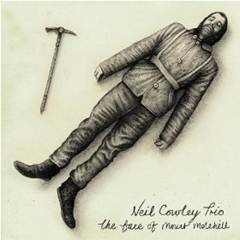 | Neil Cowley Trio - The Face of Mount Molehill (Naimjazz/Planet)
|
UK pianist Neil Cowley’s background is in the rock, soul and funk scene, most recently with the band Brand New Heavies. This is the fourth album from Cowley’s trio and it continues those influences, with a nod to jazz aspects – especially The Bad Plus – and frequently adding a nine-piece string section. Bassist Rex Horan and drummer Evan Jenkins are ex-Australian musos of long-term residency in London. All of these tracks, Cowley originals, are strong on melodic, pop-oriented, danceable themes. The opener, Lament employs a rustic piano melody, building it up with on-the-beat riveting machine chords to bring in sweeping strings. The next track Rooster Was a Witness is a complete contrast to the intro piece with a stompy, toc toc beat and insistently rocky piano underlining the arrival of romantic soundtrack strings in a gratuitous effect. Inventive bass work features in Divorce by Clockwork in a series of stopped passages with flowing piano, a heavy beat, and shimmering strings. The title track introduces reiterated chords to pounding drums, percussive effects and a mountain of exuberance, while the quietest track is Sirens Last Look Back with an almost semi-classical fluidity of a piano theme, assisted by imaginative bass, occasional strings and an absence of drums. It’s back to a heavy beat and a rock riff to open Fable, and what to make of the crackpot laughter mixed with orchestral sounds on Mini Ha Ha? These are competent musicians working hard at an elusive mix of originals incorporating rock-inclined jazz, obviously, for the most part, aimed at a dance-inclined audience
  
|
By John McBeath
Previously published in The Australian |
| Back to Index |
| 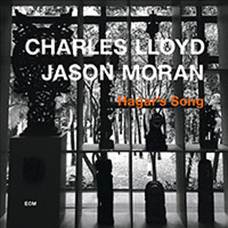 | Charles Lloyd and Jason Moran - Hagar’s Song (ECM/Fuse)
|
US saxophonist Charles Lloyd, aged 75, qualifies as a grand old master of jazz. Since 1961 he’s played with many in the American jazz firmament, including Chico Hamilton, Cannonball Adderley, Keith Jarrett and Herbie Hancock. Lloyd led his own groups to record over forty albums, one of which Forest Flower, from the 1968 Monterey Jazz Festival, became a commercial hit and remains an iconic performance. He’s also played with B B King and Howlin’ Wolf and spent most of the seventies touring and recording with The Beach Boys. Multi-award winning pianist Jason Moran a member of Lloyd’s group for six years, appeared at the 2010 Melbourne International Jazz Festival. In this duo album, dedicated to Lloyd’s enslaved great-great grandmother, he plays alto and tenor sax, plus bass and alto flutes. There is a scattering of standards plus Lloyd’s originals, notably a five part, 28 minute work, Hagar Suite, a deeply moving collection charting Lloyd’s Afro-American roots. The suite opens with a melancholy solo bass flute in Journey Up The River, joined by Moran’s soulful piano, gradually adding rhythmic dissonance. Part iv, Bolivar’s Blues features alto sax weaving a blues line over rumbling piano bass, while the final section Hagar’s Lullaby moves from serenity to anguish and back again. Ellington’s Mood Indigo opens with Moran’s jaunty stride piano, Lloyd’s nostalgic tenor soon breaking out into hyper-fast runs, and adds Moran’s ingenious Art Tatum-like solo. The ballad All About Ronnie has Lloyd tenderly expressive on tenor as the piano ripples, then crunches an occasional massive chord. An album of stimulating exchanges and flourishing improvisation
    
|
By John McBeath
Previously published in The Australian |
| Back to Index |
| 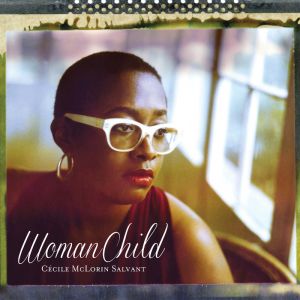 | Cecile McLorin Salvant - Woman Child (Mack Avenue MACK 1072)
|
In recent years veteran vocalist Catherine Russell has been the predominant force in re-invigorating truly vintage tunes. Now 23 year old Cecile McLorin Salvant takes the art to the next level bringing century old tunes back to life and managing to maintain their original integrity. Ms McLorin Salvant is a Florida native from a French mother and a Haitian father. She was the 2010 winner of the Thelonious Monk competition and she is now making the jazz world stand up and listen very intently. The dramatic expression in her vocals when interpreting a lyric leaves listeners with no doubt she understands the lyric to the point of literal reality. Take her quavering tremolo during the Jitterbug Waltz. “here we are still dancing...Our feet can barely move, my legs are yelling whoa” The listener hears her legs feel like jelly from so much dancing. Her style would not be out of place on Broadway. Ms McLorin Salvant can sound like a young Sarah or Betty Carter or a mature Sarah or Russell within the space of 1 or 2 phrases. Her breathy climax to ‘What a Little Moonlight can do’ is almost erotic. Her band is just as dramatic when drummer Herlin Riley conjurs a chest beating homo-erectus with his toms during ‘You Bring out the Savage in Me’
    
|
Peter Wockner
|
Since winning the 2010 Thelonious Monk Award US/French/Haitian vocalist Cecile McLorin Salvant has been widely acclaimed as a most ‘original, versatile, elegant, insightful, and virtuosic’ new US jazz vocalist. The NY Times credited her with the talent and ability to extend the lineage of Holiday/Vaughan/Fitzgerald, a huge accolade, and she’s only 23 years of age. I had the unforgettable experience of seeing her perform in New York in July in front of a music industry audience. That performance, presenting this album, was backed by a world-class quartet led by the brilliant accompaniment of pianist Aaron Diehl, who perfectly supplements the vocalist’s individual stylings. She can make traditionalist songs sound new again, as in the early Afro-American tune John Henry given graceful swinging treatment with an evocative, lightly percussive hammer backing from Herlin Riley. Standards are embraced, including a sensitive I Didn’t Know What Time it Was with an unusual stopped accompaniment of first and third beat emphasis and a thoughtfully adroit double bass solo from Rodney Whitaker, in addition to Diehl’s descriptive piano, as the vocal takes on fresh phrasing and profound expression. McLorin Salvant employs a wide range of techniques, showing an extreme but not over-used top range in the ending to What a Little Moonlight Can Do; or clever emphasis, power and delicate humour in You Bring Out The Savage in Me and the satirical Nobody. Right from the sultry opening, a 90 year-old Bessie Smith song St Louis Gal with James Chirillo’s solo guitar, it is obvious that here is not only a wonderful interpretation of a New Orleans blues, but also a sensational, new jazz vocalist
    
|
John McBeath
Previously published in The Australian |
| Back to Index |
|  | The catholics - Yonder (Bugle Records/Fuse)
|
Sydney bassist Lloyd Swanton’s septet The catholics are not only one of Australia’s most distinctive contemporary groups – at over 22 years of age they’re also one of the longest established. Although many top-flight players have featured with the band, there’ve been surprisingly few changes in original personnel. The most recent addition is accordionist Gary Daley who adds an enhanced global dimension to the group’s existing ethos of jazz/world music, two genres’ whose demarcation lines have been eroding since Dizzy Gillespie visited Cuba in the 1940s. In this, The catholics eighth album, eight of the nine tracks are band-member originals. The exception is the title ballad from the 1933 film I Cover The Waterfront where Hamish Stuart lays down a reggae beat for some fine trombone work from James Greening alternating with Daley’s seaside-sounding accordion. Swanton’s Sleepout moves into a different groove: a salute to Bobby Timmins’s Moanin’ sounding as if that soul standard had been re-worked as a bop piece with extended harmonies, adding Greening’s trombone solo sliding, growling, stuttering and wailing through a fantasy of inspired New Orleans soundbites, to conclude with Jon Pearce’s flashing guitar. Opening with composer Sandy Evans’s soprano sax together with pocket trumpet and accordion stating the theme over a bass ostinato, Floating on an Emerald Green Sea drifts languidly, yet builds to Evans’s whirlpool of a solo. Indigo, a slow, stately and evocative piece features its writer and percussionist Fabian Hevia strumming chords on the Cuban tres, a guitar with three sets of twin strings. The latest catholics album is a perfect extension to the finely crafted repertoire of these highly skilled professionals
    
|
John McBeath
Previously published in The Australian April 2013 |
| Back to Index |
|

Origami - Karaoke
(Fat Rain/Trailbazer Records) |

Origami - The Usefulness of Art
(Fat Rain/Trailbazer Records)
|
Melbourne trio Origami, led by saxophonist Adam Simmons released their 2011 debut album, The Blues of Joy to widespread commendation. Part of that success was due to a well-selected variety of themes and styles, from a reworking of a Country classic to a bouncy, almost delirious effect on Simmons’s original title track. The group was finely integrated too with Howard Cairns on double bass and drummer Anthony Baker
Similar sentiments apply to The Usefulness of Art, a six-part suite where Simmons plays a beautifully resonant bass clarinet throughout. It’s a contemplative work, which is not to say there are no lively tracks; at least one, Generosity swings well after a subdued beginning building up to an expressive drum solo that faithfully speaks the theme in a percussive language. An equally impressive solo from Cairns’s bass concludes the section
Most of the suite is moodily introspective from the bass-underpinned tremolos of Acceptance to the out of tempo blues-inflected opening lines of Empathy slowly building to a pulse. Rustling brushes, soft gong-like cymbals and fast repetitive bass notes open Compassion before the tentative bass clarinet appears. The final track, Faith employs a haunting theme stated in strong sequences by the leader. This is Simmons’s first recording using a newly acquired instrument and perhaps this explains an occasional reed squeak, but none serious enough to spoil the overall effect
The Karaoke album in this double release features all-Australian, mostly pop compositions, from Gotye’s Hearts a Mess and Nick Cave’s The Mercy of Seat, to the traditional Streets of Forbes, all given jazz interpretations with Simmons on alto sax throughout. The problem here is that very few pop songs, once stripped of their lyrics have sufficient harmonic interest or melodic variety to be well suited for jazz improvisation. (US critic and musician Ted Gioia points this out in his new book The Jazz Standards.) Simmons works hard at the challenge but too often with a bathetic result. Gotye’s Someone That I Used to Know is an example, where a thin melody line doesn’t support interesting improvisation and some repetition plus musical histrionics start to appear
Silverchair’s Straight Lines probably comes off best with Cairns’s bowed bass augmenting the alto’s thematic intro and some good rhythmic assisting work later from drums and bass. The Reels hit Quasimodo’s Dream achieves a suitably mysterious air while preserving some of the rhythmic aspects of the original arrangement while Men at Work’s Overkill achieves variations on the original’s beat and features a strong bass solo as well as the alto weaving up and down the horn to embellish the melody
Unfortunately the Karaoke album, while well intentioned, reduces the general rating of this double collection – and its appeal for jazz lovers – where a good deal more musical interest and invention is apparent in The Usefulness of Art
Karaoke -   
The Usefulness of Art -    
|
John McBeath
Previously published in The Australian April 2013 |
| Back to Index |
| 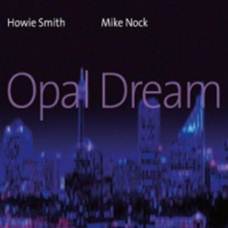 | Mike Nock and Howie Smith - Opal Dream (Open Blue/Birdland)
|
Sydney-based pianist, composer, and educator Mike Nock has appeared on over one hundred recordings during the past fifty-five years and won more awards than would fill a lift-top piano stool. He’s had an extended influence on, and participation in jazz, across the USA, Europe, and Australasia. Cleveland State University professor, saxophonist Howie Smith visited Australia in 1973 setting up the first tertiary jazz studies program here at the Sydney Conservatorium, remaining as director until 1976. This duo album showcases two grand old masters of jazz as they inspire, exchange and co-originate musical ideas, sparking wonderfully off each other. Smith’s soprano and alto display a pure clear tone while Nock’s Korg Kronos keyboard supplies a variety of judicious effects without overdubbing or overuse. Eleven of nineteen tracks are totally improvised while the others are composed by the players except for a Charlie Mariano piece He’s Gone, a ballad of deep sadness where the soprano’s melancholy theme is elaborated by a moving solo of sombre piano. Smith’s alto on To Be, Ornette, To Be, establishes a tribute to Ornette Coleman as the piano alternates between crashing chords, cascading runs, intricate figurines and unison passages. Life-like orchestral effects open and accompany The Magic Garden and a short Rag(ged) Time features stride piano and trad soprano increasing in complexity to a fade-out. Jamaican Rhum is a sprightly alto theme into which Nock deftly injects latin-timed dissonance. The title track is a profoundly beautiful soundscape vaguely reminiscent of Stardust and emblematic of the brilliant paired virtuosity in this broad sweep of an inspired collection
    
|
John McBeath
Previously published in The Australian April 2013 |
| Back to Index |
| 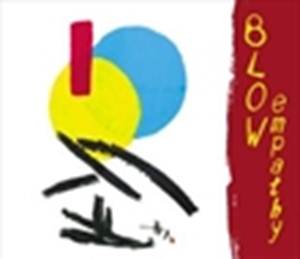 | BLOW - Empathy (Independent/Planet Music)
|
Melbourne-based group BLOW, evolving in 2000 from other combos, has had several changes of personnel, but founding members drummer Ted Vining and pianist Bob Sedergreen have been playing together since 1969. Back then they formed the acclaimed Ted Vining Trio with the late bassist Barry Buckley. Empathy is BLOW’s fifth album, and it’s quintet size, including trumpeter Ian Dixon and saxophonist Peter Harper with bassist Gareth Hill. Everyone contributes robustly, and Vining has always been a powerful drummer, so that the ensemble work often sounds like a larger group. The opener Moonlight In Addis by Harper begins in a suitably mystical mood with chiming keys, tentative acoustic bass and percussive effects before settling into a trumpet and tenor theme of long notes and Harper’s raucous-edged solo, riding a six-eight beat, followed by Dixon’s commanding trumpet. It’s right down into funkysville for Simon’s New Orleans, a style in which Sedergreen is a master and he excels here pushing the piano into a blues-drenched standout straight from Bourbon Street, a perfect intro for gutsy tenor and high register trumpet exchanges. The New Orleans component reappears in Abdullah Ibrahim’s Marabi Blues affording Sedergreen another demonstration of his mastery of the genre, plus an opportunity for bass and drums to show their integrated expressive understanding. A quite different approach is used in the title track Empathy, a free improvisation piece using a variety of unearthly sounds to create an aural landscape. John Coltrane’s Africa employs bass and cymbals establishing a jagged rhythm for its post-bop treatment of the theme, providing another quality dimension for this diverse album
   
|
John McBeath
Previously published in The Australian April 2013 |
| Back to Index |
| 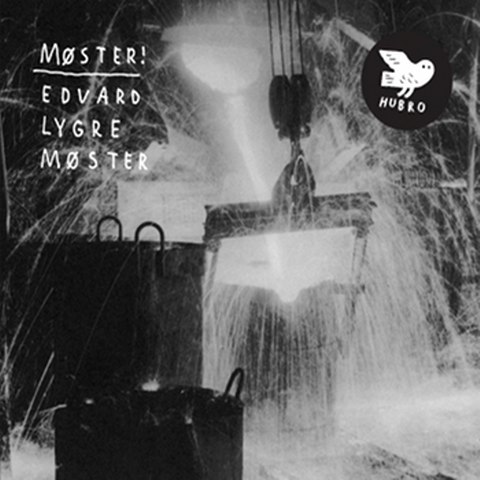 | Kjetil Moster - Moster! Edvard Lygre Møster (Hubro Music)
|
Live performances invariably have that extra level of intensity when compared with studio recordings. This one has it in spades. The 37 year old Norwegian saxophonist Kjetil Moster has had a career steeped in rock and heavy metal as well as jazz. His tenor tone leans towards Rollins and his phrasing can be reminiscent of our own Sandy Evans. The old cliché that the band was much more than the sum of its parts is certainly true in this case but that should take nothing away from each of the stellar cast on this recording. The sounds lurch from unadulterated rock to post industrial modal moods (thanks to Stale Storlokken’s moog) to 1970’s fusion and funk. Recorded in Oslo in Dec 2011 in front of a large crowd, the sound quality is exceptional. Kenneth Kapstad’s drums are about as thunderous as I can recall (save Elvin Jones) but in this heavy aesthetic, are never out of place. Full of confrontational pleasure, all four compositions written by Moster are lengthy and grow in stature as each piece develops, building tantalising tension.
    
|
Peter Wockner
|
| Back to Index |
|
 |
Edouard Bronson - Intimate (Independent)
|
By its dry dictionary definition, the word eclectic means "something made up of elements selected from various sources". I would add "clear, warm, nostalgic and reflective" to describe a new offering, eclectic by design, from Edouard Bronson - "Intimate". Different languages, stylistics, time lines - all of these creates a very charming atmosphere.
Bronson brings his life experience, big heart, very Mark Bernes-style voice and his trademark accordion and soprano saxophone lines. John Maddox's very creative and intricate finger-work on bass guitar and Daniel Pliner's piano solos add spontaneity to a good measure.
The percussion section keeps everything well organized and structured. Bronson also introduces a new face to the Sydney jazz scene, the 17 years old drummer Lucas Volfneuk - well done, Lucas.
My favourites are "A Dream of You", "Ballad" and "Aznavour" - they go very well with a drop of old port.
   
|
|
by Vlad Gilbourd |
| Back to Index |
| 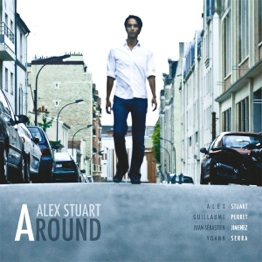 | Alex Stuart - Around (Independent/www.alexstuart.tk)
|
After completing an ANU degree in 2005, Canberra guitarist/composer Alex Stuart moved to Paris where he’s won several awards, including Grand Jury Prize at the prestigious Jazz a Juan Festival, and he’s appeared at many other festivals, including the 2012 Wangaratta Jazz Festival. Stuart’s influences include the usual jazz luminaries, but also some popular artists such as Radiohead and Bjork, plus the music of Africa, Asia and Latin America. His quartet features Guillaume Perret on tenor saxophone, Juan-Sebastien Jimenez on double bass and drummer Yoann Serra. The title track has the flavour of Moorish Spain with an Andalusian broken rhythm established ahead of a forceful duende-drenched sax solo, then Stuart’s guitar connecting, relating, and advancing the uptempo mood driven by punctuating percussion to the closing theme. A polyrhythmic West African scenario inhabits Wake Up where quick-bowed bass and countervailing drums introduce the saxophone-overlaying-guitar melody to erupt into a powerful sax solo of emotional highs with fast tremolos and a truly Afro-jazz conclusion of muted guitar and bass notes beneath whimpering and moaning sounds. A fresh take on Latin rhythms appears in Samba de Charles as stabbing guitar chords and hard-working drums underpin the swinging samba sax before an unexpected bass solo takes the lead. A combination of breathiness and unearthly sax sonorities introduces a guitar flow of relaxed ease and chordal beauty in Thanks, as the sax incorporates the ideas and gradually builds intensity to end back at the beginning with strange, but oddly musical squawks, squeaks and shrieks. This is an unusually cohesive and self-influencing quartet highly capable of exploratory interpretations of the leader’s varied and original compositions
   
|
John McBeath
Previously published in The Australian March 2013 |
| Back to Index |
| 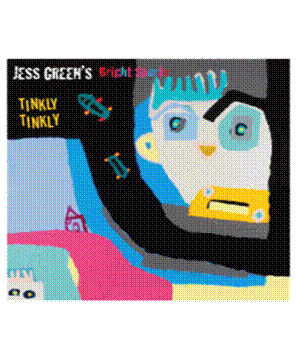 | Jess Green's Bright Sparks - Tinkly Tinkly (Yum Yum Tree Records)
|
Sydney guitarist/vocalist/composer Jess Green has gathered seven other influential musicians for a genre-crossing album of her compositions, originally commissioned by the ABC’s Mal Stanley. The publicity mentions raucous rock mash-ups, country-afro grooves, serious music portraiture, smatterings of minimalism and guitar-based romps, and at least the first two and last descriptions apply. Jazz fans will be impressed with a variety of stand-out solos from Green, bassist Zoe Hauptmann, altoist Dan Junor, Matt Keegan on tenor and trumpeter Simon Ferenci. The trumpet solo on Orange Rock Song works particularly well, initially backed by just single note guitar and Evan Mannell’s drums with John Hibbard’s trombone-led ensemble riffs gradually creeping in behind. The title track opens true to its name with tinkling vibes counter-posed with a repetitive tenor-led ensemble giving way to an untinkly, but strong jazz rock guitar solo underpinned by electric bass, joined by the pumping ensemble dropping away for a softly chiming vibes ending. There is much fine playing on this collection, but perhaps an over-emphasis on repetitive riffs and themes such as on the cyclical, pounding three minute opening to 16 for 8. Sometimes too the heavy group passages are inclined to muddy the waters, losing some clarity. The opening and longest track at eleven minutes, Bamako Youth carries the promised country-afro groove well with an appropriate guitar solo and a Paul Simon ‘Gracelands’ style vocal from Green plus a throaty, racing tenor solo. Overall the album fits a jazz rock characterization, expertly playing often interesting compositions, but occasionally over-extending just a few too many reiterative sequences
  
|
John McBeath
Previously published in The Australian March 2013 |
| Back to Index |
| 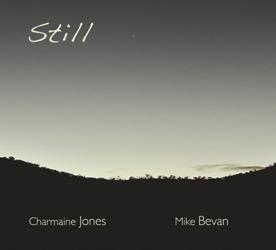 | Charmaine Jones and Mike Bevan - Still (D-musica)
|
Since their debut release A Small Hotel in 2012 this Adelaide duo of vocal and guitar have gone from strength to strength, playing interstate gigs and achieving substantial national radio airplay. The new album is another mix of originals and well-selected standards. Charmaine Jones has all the requirements for an outstanding vocalist – pitch, range, diction – plus an instinctive ability for jazz phrasing and expression. Mike Bevan’s guitar keeps an empathetic, constantly moving substructure of inventive chords, fill phrases, and an occasional inventive solo. The opener, Rogers and Hammerstein’s waltz-time showpiece, It’s a Grand Night For Singing, not often given a jazz interpretation, is managed extremely well as Jones works over the structure improvising and delicately embellishing the melody. The beautiful Cole Porter ballad Every Time We Say Goodbye features a graceful guitar intro and after a chorus of Jones’s exquisite expressionism Bevan delivers an elegant solo to re-introduce another highly individualistic vocal chorus ending by Jones moving in steps into top end soprano range. The title track Still, an original with a bop theme reminiscent of Annie Ross, complete with an intricate scat chorus also includes an astute guitar solo, while New Bossa ventures into Brazilian territory with a languid ballad vocal line underscored by pulsing latino guitar. The closing track, Ray Noble’s The Touch of Your Lips begins with a softly swinging guitar and a scat passage before settling into the well-known refrain but with the melody subtly altered and expanded in Jones’s unique rendition. A varied and masterful collection by two artists at the top of their form
   
|
John McBeath
Previously published in The Australian March 2013 |
| Back to Index |
|  | Trichotomy - Fact Finding Mission (NAIM/Jazzhead)
|
The piano, bass and drums trio formerly known as Misinterprotato, Trichotomy has sharpened its focus while at the same time added the abounding aesthetics of guests James Muller’s guitar, Linsey Pollak’s reeds and Tunji Beier’s percussion on some tracks. The title track opens with a collision-like jolt ahead of the downbeat and then goes on to provoke reflection against a series of spliced samples of political posturing from past Presidents focussing on the ideal of transparency in government . The melody is quirky and chameleon like, underpinned by a deep seated groove. All nine compositions were written either by pianist Sean Foran or drummer John Parker who adeptly punctuates rhythms and shifts gears with the precision of a formula one driver
   
|
Peter Wockner
|
| Back to Index |
| 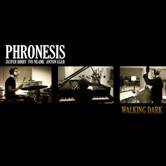 | Phronesis - Walking Dark (Edition Records)
|
Sometimes I think it is Europe that will save Jazz – not that Jazz really needs saving, just as Rock doesn’t need saving, but both could do with the occasional cracker up the wazoo.
Whenever Jazz seems threatened by the over-zealous or paralysingly-respectful American approach, I am heartened by Northern sounds such as Esbjörn Svensson’s E.S.T. (R.I.P. the band and the man) from Sweden or more recently Norway’s crushingly heavy Elephant9. I also think back to the enormous popularity among the hashish-and-Escher set of the arty ECM label from Germany, who gave us Chick Corea and Keith Jarrett (American’s ignored initially by their homeland) and continues to break new and intriguing artists to this day
The recent release of Walking Dark by Scandinavian-British trio, Phronesis, as well as reminding me of that particularly European approach to improvised music, is a delight. I say ‘improvised music,’ instead of Jazz, as their approach seems – like so many Euro Improv artists – to have leached any trace of the Blues out of it, finally cutting off that already shrivelled branch to Mother America
The Euro approach seems to take as much from Northern European classical music as anything else, and (surprisingly) Latin music – especially the rhythmic quirks of Cuban music, which in itself was a beautiful mongrel of Spanish, African and anything else that happened to sail into port. Blues out, Latin in – ‘Chega De Saudade’ indeed
Just check out Walking Dark’s ‘Upside Down’ which starts with a single, repeated syncopated piano note from Ivo Neame (UK). This simple-yet-complex motif is soon joined by the bass of Jasper Hoiby (Denmark) and the drums of Anton Eger (Sweden) to create a very Latin lattice of cross-rhythms and cross-currents that works so perfectly. Maybe it is because the piano cannot bend a note that the Blues is banished but I don’t see that as the full story. Phronesis seem to work best when creating this mesh of sound and pulling and pushing it into different texture and shapes
Phronesis – the word means ‘wisdom’ or ‘intelligence’ or, more specifically ‘the wisdom to change our lives for the better’ – is the brainchild of London-based bassist Hoiby and was formed in 2005. The group has been described by Jazzwise Magazine as “the most exciting and imaginative piano trio since E.S.T.” and I think they are right
Much of this excitement, to my ear, comes from the democratic approach of Phronesis, each player given entirely free rein to move their strand of the music forward as they see fit, or feel at the time. In this sense, ‘democratic’ is not an accurate term, as it suggests a lowest common denominator. Phronesis are all leaders – they just lead simultaneously (is this the essence of true democracy?). Check out some of the improvising – or ‘blowing’ sections – on Walking Dark, such as the middle of ‘Lipwash part II’ or the drum solo over a groovy montuno (there’s that Latin vibe again) in ‘Zeiding’
Walking Dark is a revelation. Any Radiohead or Brian Eno fan out there will dig it – once again, the European-ness of it all brings it together
Thinking of checking Jazz out? Now’s the time, Phronesis is the band, Walking Dark is the album
   
|
John Hardaker
|
| Back to Index |
|  | Steve Barry - Steve Barry (Jazzgroove)
|
Ex-Kiwi, now Sydney-based pianist/composer Steve Barry’s debut trio album of ten of his originals is steadily gaining plaudits. Currently undertaking a PhD in piano performance at the Sydney Conservatorium, Barry is in high demand as a sideman and has chalked up appearances with prominent Australasian and international artists. The trio, with bassist Alex Boneham and Tim Firth on drums, is joined on three tracks by guitarist Carl Morgan. Barry’s compositions and playing display a rare combination of melodic accessibility with a sophisticated level of musical inventiveness. His solos flow expertly in unexpected, yet logical and highly pleasing directions. The opener, BW starts with a quick unison passage between bass and the piano’s bass notes before an interlude of tempo-less, appropriately dissonant piano chords; Boneham’s fast and precise solo re-introduces piano excitement as Barry courses and stomps with cymbal-clashing encouragement. Guitarist Carl Morgan appears on Changes, a nine minute piece, featuring an inspired bass solo and stoking exchanges between piano and guitar to a concluding build-up of big, slow-marching piano chords under the guitar theme. Big slow piano chords are also heard opening Breathe Deep with wandering treble notes gradually supported by brushes and bass as all three intensify and strengthen in a composition that really does portray its title. Clusters is a sensitive theme introduced by bass and piano in unison as Firth’s mallets provide a percussive backdrop. The guitarist rejoins the trio for Sparse, to state a theme over firm piano chords and repetitive notes from the bassahead of swinging solos from piano and guitar with powering drive and an invigorating solo from drums
   
|
John McBeath
Previously published in The Australian Feb 2013 |
| Back to Index |
| 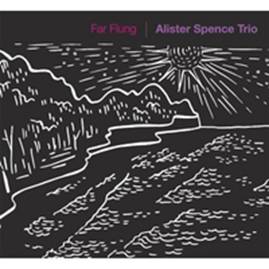 | Alister Spence Trio - Far Flung (Rufus/Universal)
|
This double CD from Sydney pianist Alister Spence’s well-established trio is a combination of free improvisation, jazz compositions by Spence, transcriptions of previously improvised co-compositions, and post-production overdubs. It’s a hefty serving of nineteen tracks and Spence, with bassist Lloyd Swanton and Toby Hall on drums, have the chops, ideas and integration to bring it off. The instruments are played both conventionally and in a prepared manner. The overall impression is of a collection of phantasmic soundscapes. It’s tempting to compare these works with music by The Necks, also featuring bassist Swanton, but Spence’s trio does not rely on repetition to the extent used by The Necks and when phrases here are repeated they build a strong narrative with more creative exploration, devoid of formula. On disc one Flight Plan moves at high speed with pounding bass, quick piano cascades and rhythmic tapping, contrasting with the follow-on, (With) Thanks, a short solo, soulful rubato piano piece, then a bluesy Felt blends piano and glockenspiel with strongly pulsing bass and drums, subsiding into a soliloquy with sinewy bass and piano mounting the tension. Disc two’s opener, Life-Wish has deep, slow ruminative piano chords and ethereal high treble notes, while the glockenspiel returns for Threading The Maze, replaced by lightly pulsing piano, soon joined by bass and brushes introducing a robust bass solo. Brave Ghost is a more orthodox track in a jagged rhythm with some fine piano using huge extended chords and fast-running post-bop phrases over an ostinato. This is an album of varying colours, ranging from spacious dream-like sequences to spirited swinging, all conveyed with imagination and originality
   
|
John McBeath
Previously published in The Australian Feb 2013 |
| Back to Index |
| 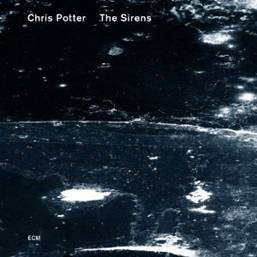 | Chris Potter - The Sirens(ECM/Fuse)
|
New York based saxophonist Chris Potter, whose playing dazzled everyone at the Melbourne International Jazz Festival in 2012, has appeared on over 100 recordings, more than a dozen as leader. Potter also impressed in bassist Dave Holland’s outstanding New York quintet at the Wangaratta Jazz Festival in 2007 where, with trombonist Robin Eubanks, he made front-line magic. A poll by Downbeat magazine voted Potter second only to tenor great Sonny Rollins and in a recent interview in New York City Jazz Record magazine the saxophonist says of his music: ‘For me, the whole point of it is to feel alive.’ That vibrancy is obvious throughout this latest album.
Fronting his own quintet, in addition to tenor, Potter also plays soprano sax, and bass clarinet. The sidemen are a stellar bunch too: long term associate Craig Taborn on piano; Larry Grenadier on double bass, a corner-stone of the acclaimed Brad Mehldau trio; multi award-winning drummer Eric Harland; plus David Virelles adding the delicacies of prepared piano, celeste and harmonium on four numbers. Nine tracks, save one, are Potter originals and right from the opener Wine Dark Sea, Potter’s virtuosity leaps out. The leader’s commanding display of lyrical sensitivity and impassioned exploration at the out-of-tempo beginning to track one precedes piano, bass and drums setting the scene for a rhythmic sequence driving the tenor into high speed and high register phrases of extraordinary invention.
Inspired by Homer’s epic Odyssey, Potter says he has tried, in these compositions, to portray that poem’s evocative mood. Beautifully moody vagaries of bass clarinet with a droning effect from harmonium at the start of the title track are taken up and echoed by bowed bass with mystical piano before the dominant tenor arrives to pace slowly and majestically to a deliciously mellow, long note conclusion. Kalypso is vaguely related to Afro-Caribbean music, kicking off with a kindred-sounding melody and a jagged rhythm which soon jumps into a strong, infectious beat as the tenor dips and soars all over the horn with Potter’s astonishing technique. His rubato opening to Nausikaa on soprano introduces piano and the chime-like celeste engaging serenely, as they do more rhythmically under Potter’s hastening tenor and Harland’s imaginative drumming on Stranger At The Gate.
A heartbeat pulse of the bass drum underpins Wayfinder as the tenor states a wandering theme, pushing into a stronger improvised passage as piano with alternating celeste and prepared piano shift the mood above Harland’s constantly moving drive and the tenor returns with a convoluted theme racing wildly to a powerful conclusion
A freely improvised duet by the pianists, The Shades, a short minimal final track, closes the album in a floating, ethereal space. The ECM label is highly regarded for its content and quality productions but this album might well be the company’s foremost release this year.
    
|
John McBeath
Previously published in The Australian Feb 2013 |
| Back to Index |
| 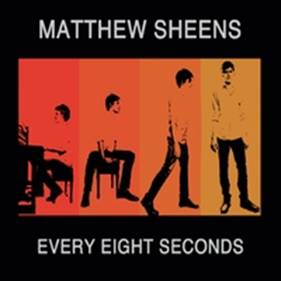 | Matthew Sheens - Every Eight Seconds (Independent/www.matthews.com)
|
So many Australian jazz artists are now based in New York, the streets – and the music venues – of that city must be thronged with ex-Australian jazz musicians. Many have released recordings over the past twelve months. The latest comes from ex-Adelaidean, multi-award winning pianist Matthew Sheens who’s achieved a Masters in Jazz Performance at the New England Conservatory studying with Fred Hersch and Jason Moran. The group contains two other ex-Australians, guitarist Quentin Angus and on double bass Linda Oh. Five more members make up a truly multi-national ensemble. The title track – inspired by Sheens learning that a new resident arrives in New York City every eight seconds – opens with rippling piano, joined by unison guitar, brushes, and the wordless vocals of ex-Portuguese singer Sara Serpa. Colin Strahan’s drumkit and Rogerio Boccato's percussion provide quick-moving effects for a piano solo of Mozartian dimensions to re-introduce Serpa’s classical scat. A lesser-known Cole Porter melancholic ballad, Who Said Gay Paree? also features Serpa, this time with lyrics and beautifully expressed anguish. Vocalist Ji Hye Sim scats cleverly through the opener, The Rain Stays Mainly In Jamaica Plain where Sheens’s rich, stately chords and rhythmically pattering notation along with guitar, strong bass lines and fast, varied percussion produce an unusual combination of African-sounding jazz. Death On A Sunny Day features Adam Kolker’s clarinet weaving smartly around the piano’s hurrying theme. Kolker also features in Cringe Culture where the duo of piano and clarinet take a semi-classical approach, especially in the woodwind solo, but the piano gradually adds more of a jazz feel before the pair concludes with an étude-like theme
   
|
John McBeath
Previously published in The Australian Feb 2013 |
| Back to Index |
| 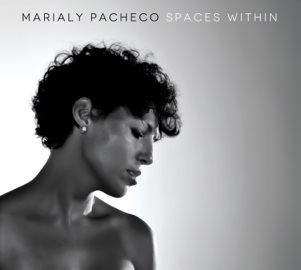 | Marialy Pacheco - Spaces Within (Pinnacles Music)
|
"Marialy Pacheco's new CD "SPACES WITHIN" had a Sound Lounge Sydney launch on 21st February 2013 following its Brisbane launch on 8th February. If you like piano music of any kind you will like this CD where Ms Pacheco, supported by brothers Pat and Joe Marchisella on bass and drums respectively, coaches a Shigero Kawai SK3 to give of its best, with the sounds of eight originals captured with fidelity by engineer Mark Smith. At the Sydney launch, Pat ( of the group TRICHOTOMY) was replaced by another distinguished bassist, Andrew Shaw
Music is feeling, mainly, made sound. Ms Pacheco claims this music was "born", a signal of her desire to make her music very much more about feelings than about say, virtuosity or simple melodies however strong. And what, on the evidence before us, are those feelings?
Overall, there is a sense of joy, of play, of new life. Yet the musical centre of the program is a suite in E minor - a chord labelled the 'mood' chord for its relationship to sounds sombre by the likes of Sibelius - and the suite might indicate a more sombre mood but it does not. The longer middle section of this impressive suite is meditative, warm, loving with a sense of longing
Other titles allude to the overall mood - September (Spring), Sale el Sol (Sun is shining) and Sonrieme (Smile at me). Yet the first track, Low Tides, begins with bell like notes of cascading water expressed in exciting right hand runs, but, in contrast, the last track is a simple repetitive motif of uncluttered purity of four notes, chant like, in a well structured meditative piece that seems in its end to release the listener with a hush. It does remind one of Ida Lupino by Paul Bley. It's a program with much variety packed into about 50 minutes
The first section of the E Minor suite, really stomps where the trio with exciting stop rhythms goes for it. The third section shows the power and strength of Ms Pacheco's playing. The meditative middle section features a striking conversation between piano and bass which is quite forward on the sound stage on this track. September is pianism of an orchestral power rich with colour and harmonies complemented by the expressive shimmering cymbal splashes of drummer Joe at the climax. Sale el Sol is playful and exuberant in mood where Pat's bass takes the lead followed by an improv by Ms Pacheco where the listener gets the uncanny feeling of being in the moment with the pianist as her fingers follow her heart and mind as it were - the sounds of surprise. Stunning
The CD bounces, swings, broods, strolls, and dances in a variety of tempos and pulses that never allow the listener to drift off
If Ms Pacheco has a problem it's with her considerable chops and the understandable urge to show us just what's what with the piano. On this CD she shows the artist's discipline and puts the music front and centre
A program of music to live with and return to from time to time
Reviewed using NAD C545Bee, through a Peter Stein ME 850 and Duntech Marquis speakers."
   
|
| Ian Muldoon
|
Cuban born, Brisbane-based pianist/composer Marialy Pacheco took out the prestigious Montreaux Jazz Solo Piano 2012 competition against 33 competitors from 22 countries. She is the first female to win the award over its fourteen-year history. After three solo piano albums, most recently in 2011, Songs That I Love, the pianist has recorded a trio album of eight of her originals with Brisbane players Pat Marchisella on bass and drummer Joe Marchisella. As she states in the liner notes Pacheco set out to create moods in this album: states of mind, colours, drastic contrasts and dynamics, and right from the rippling notes of the opener, Low Tides she succeeds admirably. Somewhat enigmatically the next three tracks are entitled No. I, No. II and No. IIIwith I and III both in jaunty rhythms, the first moving around a bass pattern with strong acoustic bass and the theme of IIIinteracting with percussive effects. The middle piece in the trilogy is soft and dreamy, roaming introspectively against a restrained and satiny chord progression, and includes an evocative acoustic bass solo. Open Spaces’ beginning builds in dramatic fashion to a measured slow march and gradually increasing dissonance before subsiding into a hushed conclusion. While undoubtedly jazz-influenced, much of Pacheco’s playing contains traces of what Jelly Roll Morton called ‘the Spanish tinge,’ and frequently has a Latin semi-classical dimension. She improvises impressively on her compositions with a highly skilled technique bursting out from big chords with high velocity runs and fast octave playing. Her sound is like a highly individual blending of Joaquin Rodrigo and Lalo Schifrin
   
|
John McBeath
Previously published in The Australian March 2013 |
| Back to Index |
|  | Joseph Tawadros - Chameleons of the White Shadow (http://www.josephtawadros.com/)
|
"Chameleons of White Shadow" is the new album by Joseph Tawadros, internationally renowned Australian oud player, whose previous album won the 2012 Aria Award for Best World Music album. The oud is a traditional Middle Eastern string instrument, resembling the European lute
In his new album Tawadros is accompanied by his brother James, on Req and Bendir frame drums, and by a stellar international cast of musicians, including banjo virtuoso Bela Fleck, bass player Richard Bona and jazz organist Joey DeFrancesco. Tawadros’ family came to Australia from Egypt, and he has maintained a keen interest in Egyptian culture and musical tradition. His music has significantly contributed to raising the profile of the oud in the western world and introducing the oud to the modern jazz scene. Compositions from the album demonstrate the artist's rich musical palette and his mastery of the instrument. Sometimes his oud completely dominates the composition, transforming it into a Middle Eastern folk melody or a Spanish flamenco piece. Sometimes it provides a slightly Middle Eastern meditative theme within a modern jazz piece, while at other times it completely blends in. Tawadros’ playing is oriental, unhurried and contemplative, but it is never boring. I enjoyed his music taking me to exotic destinations without thinking much about his harmonies and influences. Among the highlights, I would include the title piece White Shadow, the ’West meets East’ dialogue between the banjo and oud in Hidden Voices, the beautiful Street in Saraevo, which reminds me of a Balkan gypsy ballad, the oud and accordion interplay in Broken Promises and the fantastic Bendir drum solo in Tribal Bendir
   
|
Michael Gilbourd
|
| Back to Index |
| 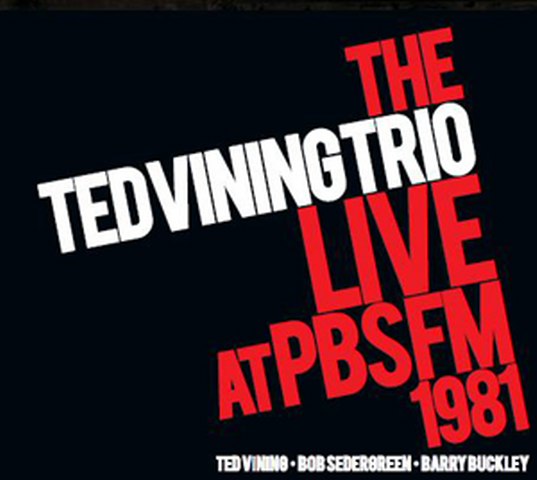 | Ted Vining Trio - Live at PBS FM 1981 (Newmarket NEW3314.2)
|
There is always a certain excitement, or dare I say it, expectation that surrounds an Australian re-release of classic old vinyl on CD, as these occasions are so rare in Oz. So when this hit my desk I couldn’t wait to hear it. The re-mastering of the original Jazznote release re-produces an honest live recording by PBS FM with all the rawness of a live pub gig and superb compositional choice. One punter who seems to be in a constant euphoric state, is way too close to the bandstand and his groans and affirmations do get tedious. This is very much Bob Sedergreen’s gig. His Petersonesque energy and inspiration seems to lead Buckley and Vining down his whimsical paths and they react and support with ease. There are four tunes on this disc. Coltrane’s modal anthem ‘Impressions’ almost turns into Miles Davis’s ‘So What’. Blossom Dearie’s waltz ‘Sweet Georgie Fame’ is followed by Dizzy’s ‘A Night in Tunisia’ while Hubbard’s ‘Little Sunflower’ stands out as the most dynamic of the interplays. The late Barry Buckley’s bass uses a pick up, typical of the era that amplifies the action rather than the wooden resonance we’ve become used to expect (sometimes sounding like an annoying mosquito)and when he finally gets his chance to solo he seemed hesitant and unconvincing. Nevertheless it’s the utter unpredictability of Sedergreen’s fancy that makes this disc an Australian classic. Live pub jazz at its spontaneous best. Yes there are flaws but they’re easily overlooked amidst the energy of the moment.
   
|
Peter Wockner
|
| Back to Index |
|  | Nostalgia 77 - The Sleepwalking Society (Tru Thoughts TRUCD227)
|
Here is an album likely to turn the unsuspecting on to jazz. Led by London based guitarist, producer and composer Benadic Lamdin, this is Nostalgia 77’s fourth studio album and rather than showcase various vocalists, Ben has chosen German vocalist Josa Peit, whose voice sits in tone territory between our own non-stereotype Elana Stone and diva songstress Kate Ceberano. Peit’s modern folk and soul inflected interpretations, helped by some luscious raw textural timbres make these attractive melodies and catchy hooks, come to life. There is no shortage of post production here but it only brings enhancement to the end result with harmonic embellishments of saxophones and cello lines. Diversity comes in a number of forms here; the blues, subtle calypso, cello/bowed double bass arrangements and some dark and heavily engaging bass clarinet.
   
|
Peter Wockner
|
| Back to Index |
| 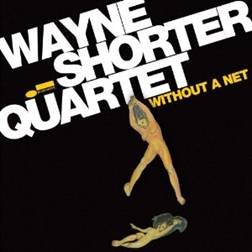 | Wayne Shorter - Without A Net (Blue Note)
|
Saxophone icon Wayne Shorter is – apart from Miles Davis – possibly the most uncompromising artist in jazz, if not in modern music. Shorter, whether in his own early Blue Note recordings, in his playing and composing for Miles’ 1960’s quintet or his time co-leading 70’s jazz-rock juggernaut, Weather Report has only ever done things Wayne Shorter’s way. And the jazz canon has undeniably been the richer for it
In March 2010, Wayne Shorter toured Australia with his quartet and – as all truly pioneering artists do – fiercely divided audiences across the country. I was at his Sydney Opera House gig and recognised more than a few of our supposedly more progressively minded jazz players in the streams leaving the hallowed hall during his set
Shorter’s new album, Without A Net is eight live recordings (and one orchestral piece) from a late 2011 European tour with the same band that blitzed Australia – pianist Danilo Perez, bassist John Patitucci and the explosive Brian Blade, a hyper-kinetic drummer that makes Keith Moon look like Karen Carpenter. This is the 80 year old Shorter’s first album for the Blue Note jazz label for 43 years – yes, the numbers suggest great age and a charitable homecoming, but Without A Net is far from a creaky, olde tyme trip: it is as vital and new as tomorrow’s sun, each track roaring out of the speakers with full-blooded urgency. It is the three younger sidemen trying to keep up with Shorter rather than the other way around
Of the three remakes on the album – Shorter also reworks his own Weather Report composition ‘Plaza Real’ and the 1933 film tune ‘Flying Down to Rio’ – the opening track ‘Orbits’ sets the pace. ‘Orbits’ was a piece Shorter contributed to Miles Davis’s 1967 album Miles Smiles – there it was a brisk bebop line, here it is a lugubrious piano riff that gets thrown around from piano to bass to soprano sax until the whole band has picked its bones.
Unlike most jazz you will hear today, it is not just one solo predictably following another but more of a group improvisation as the muse takes them. This group soloing not only aligns Shorter’s new music with the Free Jazz movement of the 1960’s but, surprisingly, with original Dixieland jazz of the 20’s. It also seems to cheese off the more conservative jazz listener more than it really should
It’s not all frenetic momentum though – the lovely ‘Starry Night’ and the opaquely impressionistic ‘Myrrh’ show the band’s more introspective side; the intro to ‘Myrrh’ in particular is like listening to music underwater, floating in a warm current, unafraid and tranced-out. The band can also pull off a great Latin groove too (Shorter has always drawn heavily on the rhythmic innovations of Cuban jazz and the harmonic quirks of Brazilian Bossa Nova) – ‘SS Golden Mean’ (with a wry quote from Dizzy Gillespie’s ‘Manteca’) and ‘Flying Down to Rio’ have a light Latin skip to them – but of course, as seen through the lens of Shorter and his band, which can be a sharpening lens or conversely, a distorting lens (groovy either way to my ear)
The centrepiece of Without A Net is the 23 minute tone poem ‘Pegasus’. Recorded with the quartet and The Imani Winds, ‘Pegasus’ moves between shadowy, veiled passages which move slowly like cloud-shadows over savannah and sharply rhythmic passages with the orchestral ensemble stabbing and riffing in and around the jazz group. As is expected of Wayne Shorter, ‘Pegasus’ is like nothing you or I have ever heard: like much of his Weather Report work, it pulls in flavours and energies from European classical music, African talking drums, American jazz and points north south east and west. The result is pure Shorter and pure wonder. Not an easy ride, but what soul-deep experience ever is?
I will give the final word to Wayne Shorter himself. When reflecting on his lifelong dedication to the path of the artist, he says “The challenge we as artists face today is to create a ‘singularity’ or an ‘event horizon’ so that as human beings we will break the cycle of ego dominated actions which through repetition keep us bound to stagnation which denies us entrance to the Portal of Life's Ultimate Adventure!”
    
|
John Hardaker
|
| Back to Index |
|  | Dave Jackson Quartet - Cosmontology (Independent/www.davejacksonmusic.com)
|
Sydney alto saxophonist Dave Jackson has been around the world literally since graduating from the Sydney Conservatorium in 2006, and his acclaimed recording with Apoplectic Trio in 2007. After studying and playing in Boston, New York, and Germany in 2011 Jackson returned to Sydney late in 2012. In New York he recorded the first album in his own name with ex-Sydney player, pianist Sean Wayland and two US musicians bassist Orlando Le Fleming and Greg Hutchinson on drums. Of the five tracks, four are Jackson’s compositions and the fifth is Bernie McGann’s D Day with its opening chorus using two bar breaks of percussive punctuation alternating with alto and piano. The alto falls silent as the piano races away flickering brightly and gathering momentum to introduce Jackson’s wavelike solo swelling and cascading in highly melodic, almost scalar passages. The title track – and the longest at over eleven minutes – is a slower piece in a ballad style with darkish undertones where foreboding piano chords plus a quickly moving bass lead into unison themes from alto and keyboard. As the piece progresses with imaginative drum and bass-work, the alto solos melodically in Jackson’s characteristic bright tone and undulating motion, and then an introspective piano solo builds into fast treble figures and softly probing chords. Into Stella, beginning with a fast-running bass intro, is a post-bop theme in a highly melodic flow – a hallmark of the album – stated in piano and alto unison with again the alto solo flowing into a phasic solo, rising and falling in silvery cycles
   
|
John McBeath
Previously published in The Australian Jan 2013 |
| Back to Index |
| 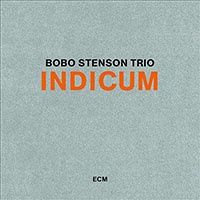 | Bobo Stenson Trio - Indicum (ECM/Fuse)
|
Widely regarded as Sweden’s foremost contemporary jazz pianist, Bobo Stenson has been recording for the ECM label since his 1971 album with saxophonist Jan Gabarek. In his trio format Stenson has included bassist Anders Jormin for over thirty years and drummer Jon Falt came on board in the early 2000s. Over the years the trio has shown a liking for Latin compositions, Nordic Classical pieces, obscure choices from innovators like Ornette Coleman and Don Cherry, plus some originals and spontaneous composition; in short a varied and eclectic palette. The latest collection opens with a piano solo tribute to, and composition by, the enormously influential pianist, the late Bill Evans – Your Story. Stenson’s performance is less dramatic than Evans’s recorded versions but nevertheless flows lyrically through the dense harmonies of this introspective piece. One of three group compositions, Indikon starts with drums establishing an odd rhythm for a full minute before bass and piano arrive with a sparse, slightly bluesy, marching-along style line. More of a ballad interpretation appears with Ermutigung, Falt’s brushes working strongly with Jormin’s muscular bass solo and the piano surging in flowing, expansive leadership. A stately Bach-like approach is evident at first in a traditional Norwegian piece Ave Maria, before a passage where tempo is dropped and Falt adds mallets and cymbals ahead of another forceful bass solo and a return to echoes of J S Bach to conclude. Event VI by George Russell, pianist/composer of Lydian and modal theory fame, also with connections to Bill Evans, opens in a minimalist out-of-tempo way, moving to a murky sequence of jagged rhythm
   
|
John McBeath
Previously published in The Australian Jan 2013 |
| Back to Index |
|
Wangaratta Jazz & Blues Festival
Various venues
Nov 2 – 5 2012
This, the twenty-third annual jazzfest in the leafy Victorian town of Wangaratta will be remembered as one of highly unusual instrumental diversity, even if the venues and decorated town looked as good as previous years. The program included the Australian group, Magnet of electric guitar, trumpet, drums and wordless male vocals; a soprano sax and accordion-led German quartet, No Tango; improvised music on the Egyptian oud; American Trio M amalgamating with Australians to add two trumpets and a second drumkit; and jazz interpretations of Peter Sculthorpe’s compositions featuring trumpet, viola, electric guitar, piano and drums.
Most impressively occupying this special musical niche was the UK trio Lighthouse, led by Tim Garland’s tenor, soprano sax or bass clarinet, with piano and an amazing array of what looked like a toy drumkit using single-skin frame drums, different-sized cymbals down to miniscule, mounted tambourine, a claypot bass udu, and a tuned steel drum, a hang. Lighthouse opened the festival on Friday night playing a range of jazz-inflected compositions with influences from Spain, Western Classical, Celtic Folk, plus sixteen-bar blues; all superbly integrated but leaving space for grooving solos.
An outstanding Australian group lead by altoist David Ades featured orthodox instruments, but played at the cutting edge, with Julien Wilson on tenor, and exceptional rhythm supplied by bassist Jonathan Zwartz and drummer Danny Fischer. The two horns traded exchanges that reached into the stratosphere with echoes of Eric Dolphy and Albert Ayler. Another altoist was the legendary Bernie McGann who sadly seemed to have lost some of his fire and passion, although his backing group led by another legend, pianist Paul Grabowsky ably compensated.
Whether as a trio of piano, bass and drums, or with added trumpets, two of Australia’s best – Phil Slater and Scott Tinkler – and an extra drumkit, US group Trio M constantly pushed the envelope. They performed a single, hour-long freely improvised soundscape with dissonant piano, and doubled percussive effects. Out front the two horns reached impossibly high harmonics and exchanged fast-running phrases, each supplying fresh ideas in an exciting duelling of impressionistic trumpets.
There was masterful, yet quietly undemonstrative playing, expertly interpreting older numbers such as Ellington’s Black & Tan Fantasy from the Melbourne piano trio of Hannaford, Anning and Browne. Drummer Browne gave one of his famously hilarious monologues and recited a poem from his recent book, Conjuror.
Sydney trumpeter Phil Slater brilliantly re-interpreted for six instruments several of Peter Sculthorpe’s classical compositions employing mystical, tempo-less passages alternating with pulsing sequences at various speeds and improvised solos. They achieved a contemporary classical feel in a jazz idiom sometimes verging on jazz-rock using electric guitar. Further diversity came in fast rhythm Middle Eastern music from Joseph Tawadros’s quartet featuring virtuoso oud playing by the leader.
Across the river from town there was a very strong contingent at the Blues Marquee, notably Chicago harmonicist Charlie Musselwhite, and New Orleans based pianist/vocalist Jon Cleary, who along with many others, pumped out the popular twelve-bar format for record crowds.
The much-publicised young French singer Cyrille Aimee, who cut a terrific, slim-waisted figure in chopstick-high heels, delivered a fairly plain vocal set of standards, adding choruses of uninspired scat. Although she entered the awards competition for vocalists Aimee did not make it to the final three. These annual National Jazz Awards are always awaited with interest and this year’s winner was 31 year-old Sydney-based Kristin Berardi taking out the $10,000 prize and a recording contract from ABC radio.
The powerful vocals of US artist Gregory Porter closed the festival with soul-drenched compositions from his latest CD Be Good.
Festival organisers expressed satisfaction with the 2012 event and Chairman of the new Festival Board, Dr Max White announced that ticket sales had shown ‘a modest increase over last year.’ Those 2011 takings were reported as $320,000.
|
John McBeath
|
| Back to Index |
| 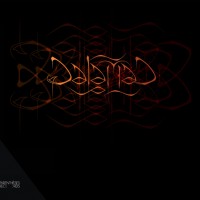 | Daramad - Daramad (Parentheses Records PREC04)
|
Perth based Daramad have an authentic Middle Eastern sound thanks to their two lutes, the Turkish baglama and the oud. The jazz flavour comes in the form of saxophone, bass clarinet and double bass. Daramad is a traditional Persian term for the process of emergence. ‘World Jazz’ by nature brings with it glorious opportunities to explore new and exciting rhythms and this disc is no exception. The band brings together Australian and Iranian artists lead by saxophonist Mark Cain whose growling tenor tone is reminiscent of David Murray and his unison lines with the zithering lutes define the signature Daramad sound. Cain is known for his bold, innovative, quirky and challenging projects such as AC/PVC, an ensemble performing musical inventions made from poly pipe. The modulated nature of these authentic originals and traditional tunes can be entrancing even mesmerising perhaps tending to repetitious for some. The group dynamics and improvisations in that rich Middle Eastern context, colour this authentic fusion, rewarding the close listener with jubilant exoticism.
   
|
Peter Wockner
|
| Back to Index |
| 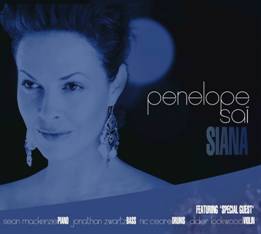 | Penelope Sai - Siana (Independent/www.penelopesai.com)
|
Singer and composer Penelope Sai, originally from Sydney, but based in the Blue Mountains since 2008, spent nine years working and studying jazz vocals in Paris. Her previous album Evening Falls, recorded in Paris, released in 2010, showcased her abilities as a composer and ballad songstress and this new one continues to display her abundant talent in those capacities. Her voice is crystalline clear, wide-ranging with a high top end capable of holding long notes, and she uses expressive, jazz-inflected phrasing. Five of the songs are well-selected standards and six are compositions where she co-wrote the melodies, and all of the lyrics. The trio backing makes a perfect vocal backdrop, from the swinging version of I’m Glad There Is You with its rolling, coursing piano solo by Sean Mackenzie, to the deeply emotional lament, He Was Too Good To Me which flows seamlessly into the gossamer vocal vulnerability of My Foolish Heart. Opening with Jonathan Zwartz’s bowed bass setting an introspective mood,Siana, a melody by Pierre Goudard with Sai’s added lyrics, features guest violinist Didier Lockwood supplying a heightened, piano-accompanied, responsive tension to an out of tempo, anguished vocal tour de force. Drummer Nic Cecire supplies a subtle Latin rhythm to another original, Scent of Jasmine as Sai soars through the impressive melody with perhaps just the faintest touch of over-emphasis. Green Skies is in a bossa tempo with piano, bass and drums working ideally together, providing a quiet but faultlessly appropriate backing for the controlled power of Sai’s luxuriant vocal. This is a satisfying album by a vocalist/composer of unusual ability with outstanding arranging and backing
   
|
John McBeath
Previously published in The Australian Dec 2012 |
| Back to Index |
| 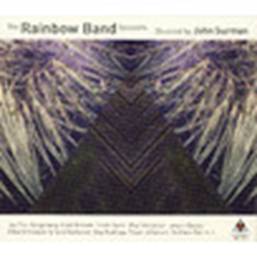 | John Surman - The Rainbow Band Sessions (Losen/Birdland Records)
|
John Surman is a highly regarded British saxophonist and composer based in Oslo Norway, where this album was recorded, at the famous Rainbow studios, home to many outstanding recordings. Surman’s main instruments, both featured here, are soprano and baritone saxes, and in the 1960s he created on baritone, perhaps for the first time, a mastery of harmonics enabling an extreme upper register. He has played with many major international jazz figures and in the 1970s introduced electronics and synthesisers in the groups SOS and Mumps, touring Australia twice with other groups in the 1980s. This latest album is best described as presenting a mini big band, shuffling fourteen Norwegian musicians around to form different nonets playing – in contemporary mainstream style – Surman’s originals. The one exception is Monk’s Off Minor, where pianist Erlend Slettevoll excels in a Monkish-style solo. Surman’s arranging skill is evident throughout the album in clever section voicings of the five melody instruments. My Sketchy Spanish, although certainly not a copy, opens with echoes of Evans/Davis’s groundbreakingSketches album using a similar Spanish marching-style drumbeat plus a creditable trumpet lead from Roy Nikolaisen and concluding with Surman’s flourishing solo on soprano sax. A bouncy piano theme begins Going for a Burton, taken up by guitar and then the ensemble building to a lift-off racing tenor solo from Havard Fossum. Surman’s soprano sax is featured on One Last Waltz weaving an animated solo against piano, bass and drums, while Bedrocks Inn has the leader leaning right into the groove on baritone in front of the pulsing ensemble
   
|
John McBeath
Previously published in The Australian Dec 2012 |
| Back to Index |
| 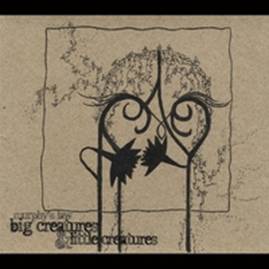 | Murphy's Law - Big Creatures and Little Creatures (Independent/www.tamaramurphy.com)
|
An increasing trend amongst jazz professionals utilises unusual mixes of instruments and this album from the quintet led by Melbourne bassist Tamara Murphy is an example. Murphy won the 2011 PBS Young Elder of Jazz Commission which funded the project. She has added to her acoustic bass, a guitar, trombone, two drummers and electronic soundscapes for an original suite of five movements, each showcasing a different ensemble member. These five ‘Big Creatures’ are interspersed with three ‘Little Creatures’ as links between movements. The approach ranges from lush textural, semi-classical washes to heavy stereo drumming, grooving or dreamy trombone, and ambient or rock-oriented guitar; in short, a comprehensive sonic diversity. The first movement, A Song for Two Rivers opens with Jordan Murray’s melodic pastoral trombone, underpinned by slow-moving bass and Nashua Lee’s guitar ostinato with the restrained percussive effects of mallets and cymbals from Danny Farrugia and Joe Talia. Rhythmic swirling brushes introduce Paircut for stabbing bass and chordal guitar building for a fiery, swinging trombone solo. A staccato trombone pattern over spaced pedals of aligned bass, guitar and mallets leads into an unexpected slashing rock guitar solo driven by a strong backbeat in Boulders Make Strong Friends. Bitter Sweet, the final movement, begins with forceful, first beat of the bar resonant bass notes ushering in quietened trombone as Murphy applies the bow to a singing bass, the guitar echoes with soft chords, and the drums supply a Latin beat while the trombone gathers force working to a dramatically percussive conclusion. This collection is an impressive set of quality ensemble playing alternating between compositional and improvised performances
   
|
John McBeath
Previously published in The Australian Dec 2012 |
| Back to Index |
| 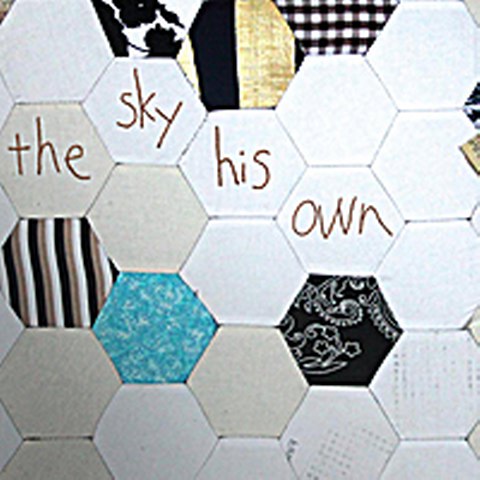 | Slumgum - The Sky his Own (Nine Winds NWCD0293)
|
Slumgum is a Los Angeles based quartet in existence since 2006. Here the group is joined by ex-Anthony Braxton trumpeter and Colorado educator Hugh Ragin playing cornet on this album. This is the group’s third release and they have recently been awarded a Chamber Music America/American Society of Composers Authors & Publishers award for ‘Adventurous Programming’. Their extreme adventures on this album however only become evident in the latter half of the program after opening with some hefty freewheeling hard bop. All five artists contribute compositions from bassist David Tranchina’s gear shifting Zoyoki gnoki to drummer Trevor Anderies Buddhist vibratory explorations in Kyo. The group’s dynamic is on display and a warm rapport with Ragin is evident throughout. His fiery solo on Silver Cornet News develops into a dual conversation with Anderies’s snare prior to Jon Armstrong joining the dialogue on soprano. Blessed with a broadness of tone that matches his invention, Armstrong goes beyond the confines of this arrangement before bringing it back to a gripping swinging head
   
|
Peter Wockner
|
| Back to Index |
|
| Archives |
|









